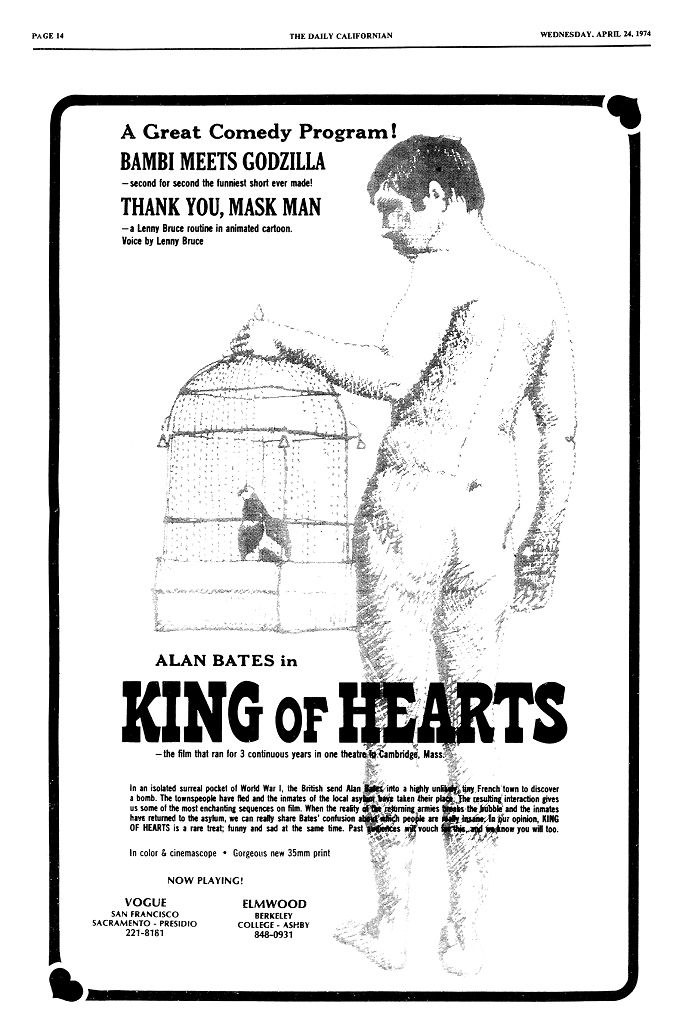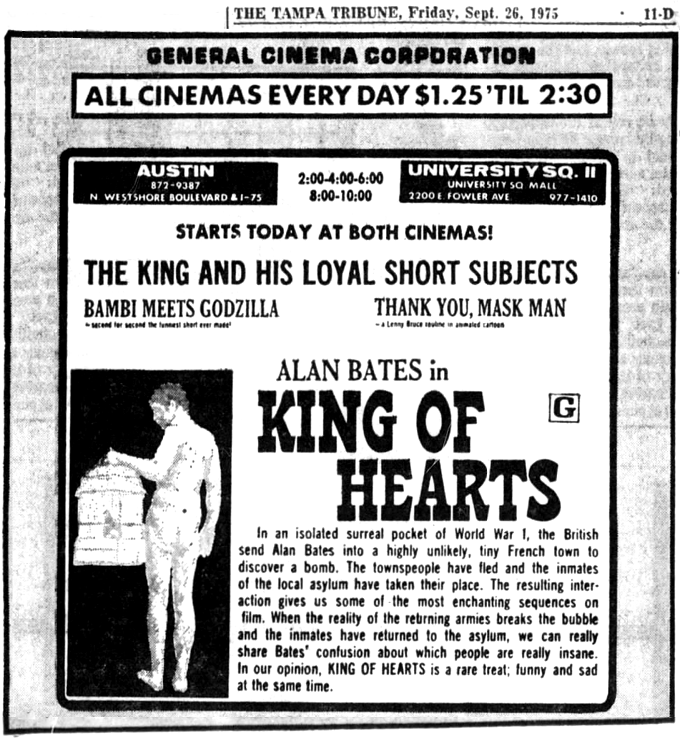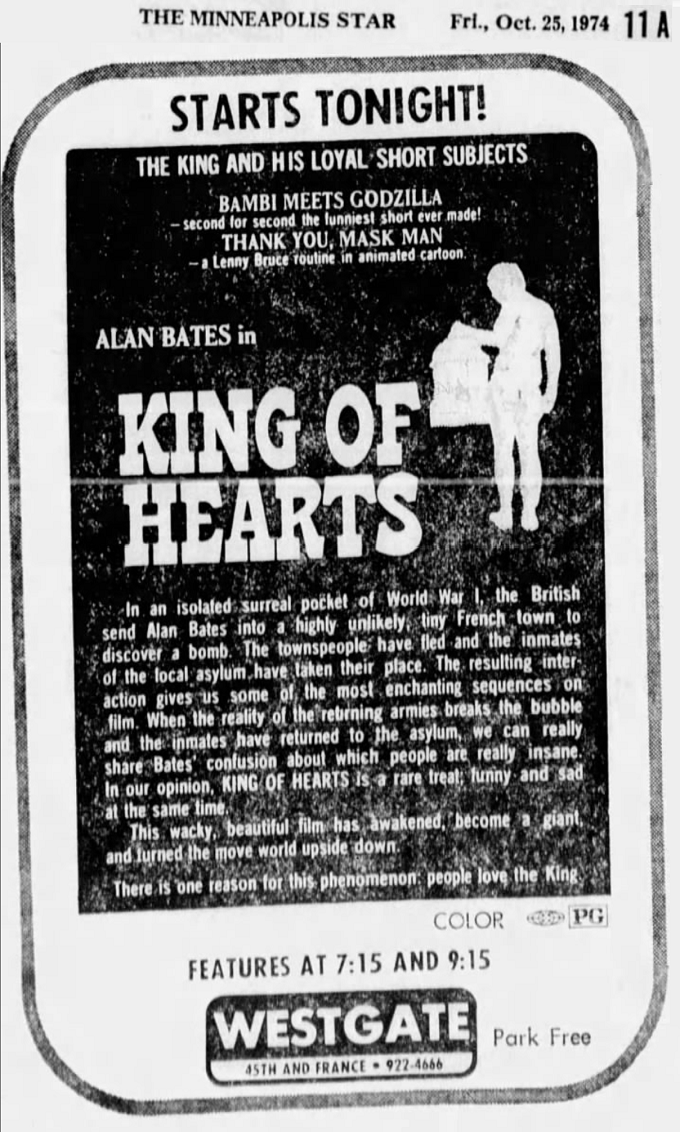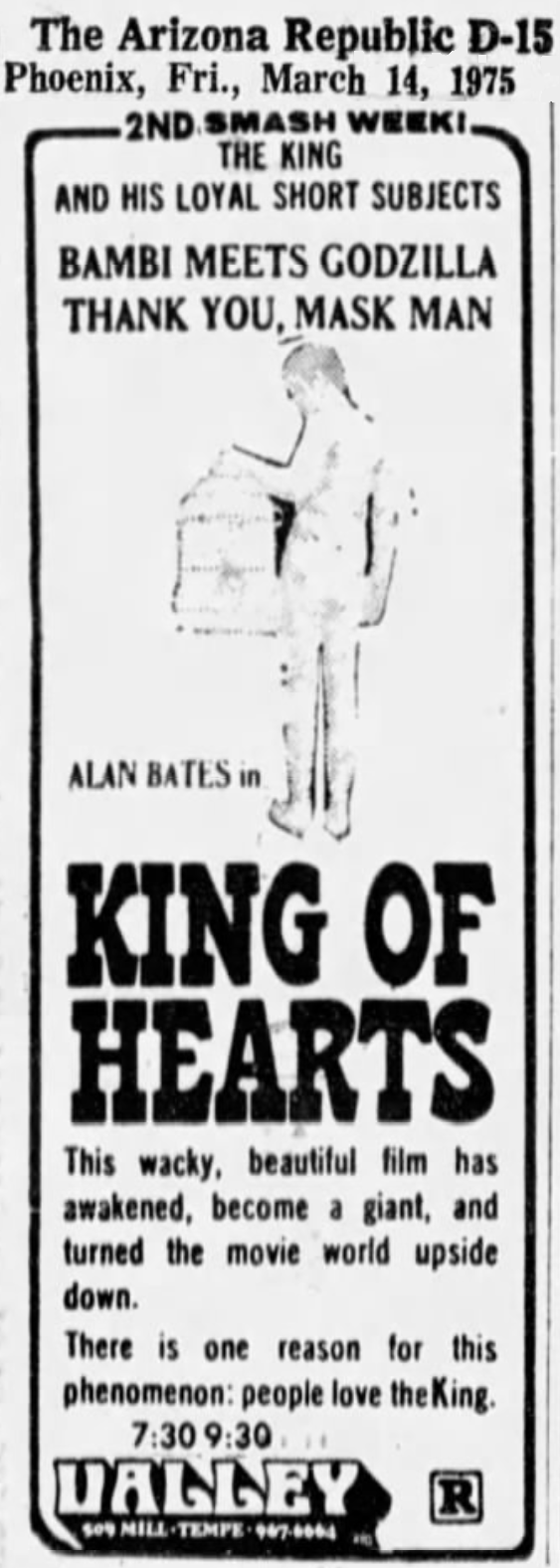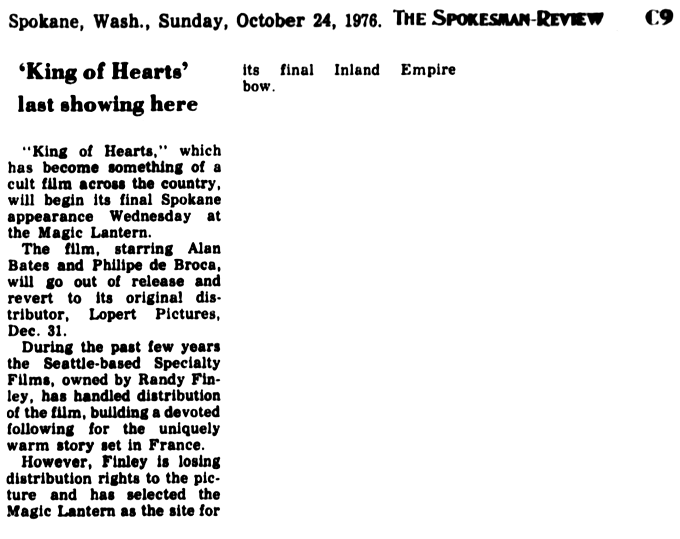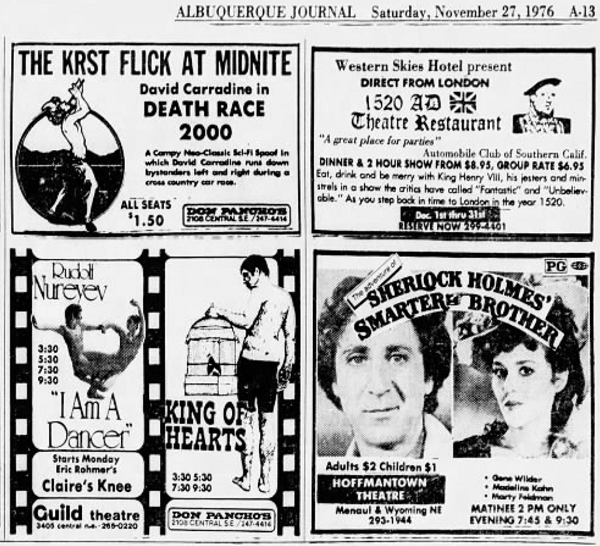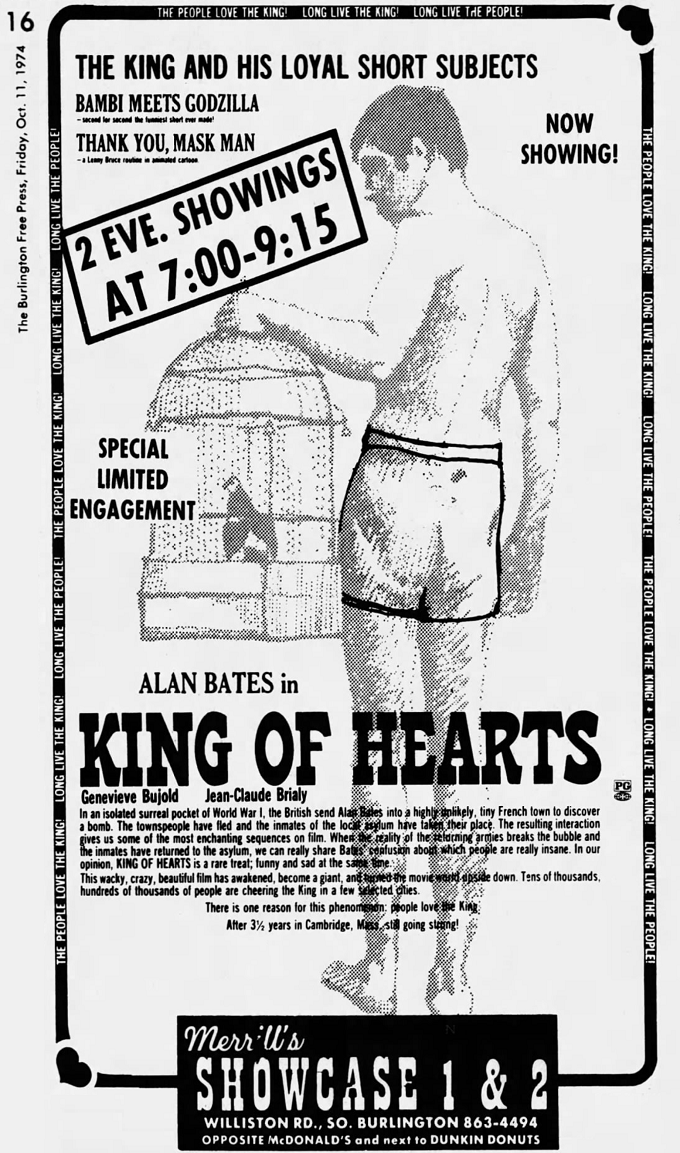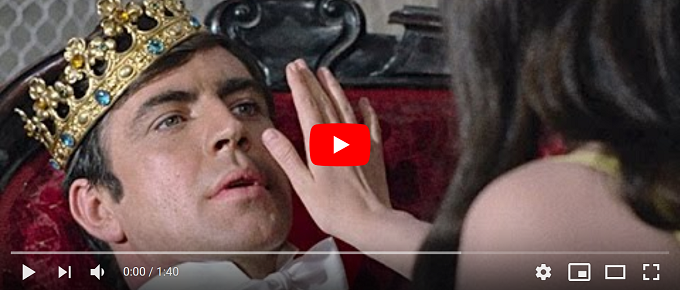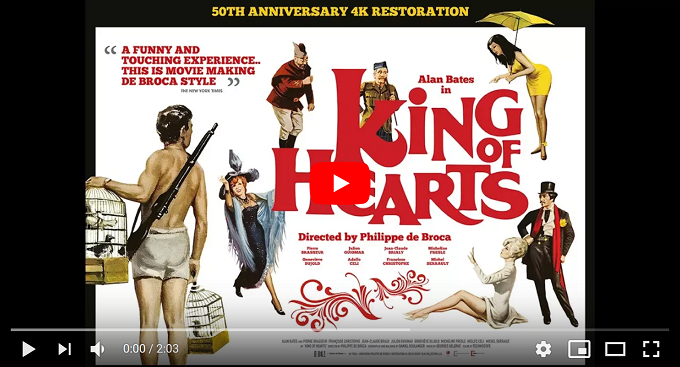According to a Mike who submitted a comment to
Ultimate Movie Rankings,
and who took as his source Wikipedia, which in turn took as its source Tino Balio’s book,
United Artists: The Company That Changed the Film Industry (Madison: University of Wisconsin Press, 1987), p. 279,
King of Hearts, presumably only in 1967, grossed a mere $580,000.
How much of that $580,000 was rentals remains a mystery, though we can with some safety guess it was a bit more than half.
That $580,000 compares favorably to the $250,000 gross for Ingmar Bergman’s Persona
or the $95,209 gross for Godard’s Made in U.S.A.
On the other hand, it fades into insignificance when compared to the $14,000,000 gross for Lelouch’s A Man and a Woman
or the $5,900,000 gross for Antonioni’s Blow-Up.
We need to remember, though, that A Man and a Woman and Blow-Up got much larger releases,
and far greater promotion.
(And neither is a hundredth as good as King of Hearts.)
I keep playing with these numbers.
So, the film played for 28 weeks in 1967, in 60 cities that we know about, and we can assume that a ticket averaged a buck.
580,000 admissions over 28 weeks comes to 20,714 admissions per week, mean average, or 2,959 admissions per day, mean average.
If we count each day on each screen, we have 1,193 days.
That’s about 580,000 ÷ 1,193 = 486 admissions per day per screen, mean average, which isn’t too bad at all.
It’s not great, but it’s respectable business, certainly.
I found a maximum of 16 prints being used on any one day in the US/Canada.
There were maybe two more in Australia.
There were probably two or three prints altogether circulating in Canada.
There may have been about five more on hand as emergency backups.
So, say there were 25 prints altogether, including a few emergency backups in each of the US, Canada, and Australia.
What does that mean?
Well, the average movie at the time was released with between 150 and 300 prints.
Maybe UA/Lopert decided not to give the US release much of a push, considering how badly it had performed in France?
I wish I knew.
It is clear that UA/Lopert had little confidence in King of Hearts,
and attempted to suffocate it here, as it had been suffocated in France.
That was despite the film’s doing rather well in its few venues with minimal publicity.
An extra push and stronger publicity could probably have increased revenues tenfold or even twentyfold.
Did some executives at UA/Lopert realize that the situation could have been bettered?
Probably, but, by that time, they were busy with umpteen other projects and just couldn’t be bothered about a small film
that they had already arranged to write off as a loss anyway.
Now, how can we determine if that claimed figure of $580,000 gross receipts for 1967 is accurate?
I have unfortunately worked in showbiz and I can assure you that no official claim is accurate
(no, not even Chaplin’s official claim that he destroyed
The Sea Gull).
What we need to understand is that King of Hearts, like the vast majority of movies, just came and went.
That’s exactly what movies were expected to do: come and go.
In that respect, it was treated no differently from almost any other movie.
You see, as far as investors are concerned, a movie is an instrument for short-term gains. Period.
It is not a work of art. It is not a museum piece. It does not have lasting value.
There is not a thought about preservation,
and, indeed, studios for decades routinely destroyed materials on films that had finished their runs.
They would often keep reference copies,
but only in case they were needed as evidence in future legal proceedings
or in case they could be used as sources for possible remakes.
An investor would find the thought of archiving a film for the future
as absurd as you would find the prospect of archiving all the junk ads you receive in your mailbox.
A film’s value is measured strictly in dollars, nothing else, and those dollars weaken after a few weeks or maybe a few years.
A movie would be shipped from here to there to there, would play a week or two or, sometimes, three,
and then it would be shipped on to someplace else.
The investors would, or wouldn’t, realize profits, and, once all the prints wore out, that was the end of that.
After a film had gotten all commercially viable play at the cinemas, it could be sold to television,
but King of Hearts was not suitable for television.
So, after a couple of years, it was done.
Once the prints were reduced to crumbs and confetti soaked in sooty black oil, it was not worth the cost to make replacement prints.
Yes, there could be a profit, but a profit too small to excite investors, who were after bigger fish.
So, the film would no longer be available anywhere.
That is how the business worked.
There were exceptions to these rules.
Disney, for instance, reissued its films once every seven years, to exploit them to the next batch of seven-year-olds.
Films that had done particularly well and that had staying power, films such as Gone with the Wind or Ben-Hur
or Spartacus, could be revived once every decade or so, in new prints, often in revised editions,
and they could make their money all over again.
The average movie, though, no, it would not be revived.
It would be scrapped and forgotten.
Cinema owners, on the other hand, operated on a different model:
A movie was a short-term opportunity for theft or money laundering.
(That’s why tickets nowadays are issued by computers, to put a damper on such activities.)
If a movie did particularly well (rare), then it could also be an opportunity for handsome profits.
That was it.
Please rid yourselves of the idea that anybody in the movie business cares about the product as anything other than a source of revenue.
People in the movie business hold in violent contempt anybody who cares about film as art.
King of Hearts did not fit the pattern.
I do not know the cost of the film production, though I assume it was rather high,
since it necessitated paying the locals of Senlis to abandon their town square from 12 April through 10 June 1966.
In other words, every business in that part of town needed its costs and losses paid up front.
I do not have sufficient imagination to make such a calculation, not even a rough guess,
except to think it was probably substantial.
It seems that UA had paid all costs minus the overage.
How much UA had recovered from the film’s releases in France, West Germany, Finland, Sweden, and Denmark, I do not know.
It probably recovered not a lira in Italy, where Compania Cinematografica Montoro or its successors received all profits.
How much the film would need to earn in the US, Canada, and Australia in order to break even, I do not know.
I do know that all the Hollywood studios were in deficit in the last half of the 1960’s (the reasons are not the published ones).
How well King of Hearts performed at the box office, I am not sure,
and, as I say, I am not convinced by that official claim of $580,000 gross receipts.
I wish I could study the profit-and-loss statements, as well as the official and unofficial grosses and nets from individual cinemas.
Nonetheless, I can ascertain some facts courtesy of online newspaper searches.
Most of the reviews were wildly enthusiastic,
and though the release was minimal, it was sufficiently broad, as the film was shipped to cities large and small.
It often played considerably longer than the usual week or two,
it often went into lengthy 2nd run and 3rd, and
at least one cinema claimed strong earnings.
The film seems not to have been a success in Australia, where it was available only in a dub,
but it continued to spread around the US and Canada for nearly two years,
and right after its first run in many regions, beginning in 1968, it immediately went into frequent repertory.
It was shown a few times at midnights but, more often, it was the second added attraction with a new feature.
Yet, something odd happened.
Tiny little “art houses” found a loyal repeat audience.
They found that they could rely on this little movie to sell tickets.
When times were bad, when a little “art house” was in the red,
the solution was simply to book King of Hearts (or Bogey or Hitch) to make up for losses.
The same audiences would attend all over again, because they found the film addictive and they never tired of it.
The problem, predictably, was the condition of the few prints, which were very few indeed and getting fewer and fewer.
Film is extremely fragile and cannot withstand abuse.
The average projectionist, working with the average projection equipment,
had all the finesse and delicacy of a jackhammer.
Prints were all battered after a single screening and, as you can guess, they did not last long at all.
According to Tino Balio’s
The Foreign Film Renaissance on American Screens, 1946–1973 (Madison: University of Wisconsin Press, 2010), p. 9,
total US earnings (gross? rentals? net?) for King of Hearts to 1973 (does that mean through 1973?)
were $5,700,000.
So there. It just took the film a while to build up its reputation and its profits.
Patience, patience, patience.
Film executives have no patience.
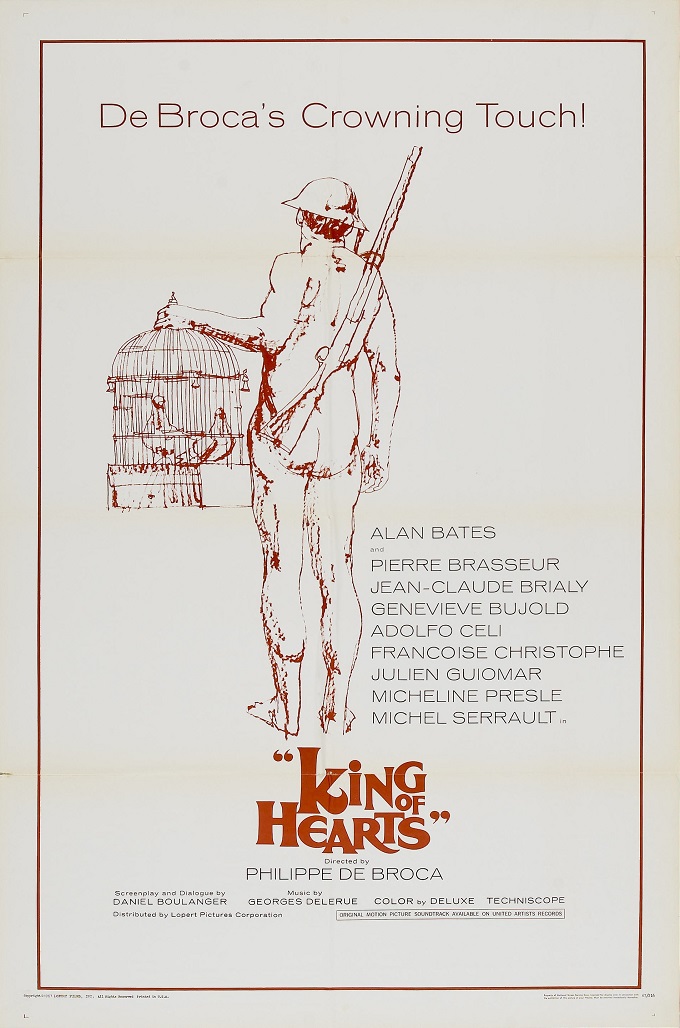 Original US 1-sheet, 1967, Lopert Pictures Corporation.
Original US 1-sheet, 1967, Lopert Pictures Corporation.
I would love to know who created this poster.
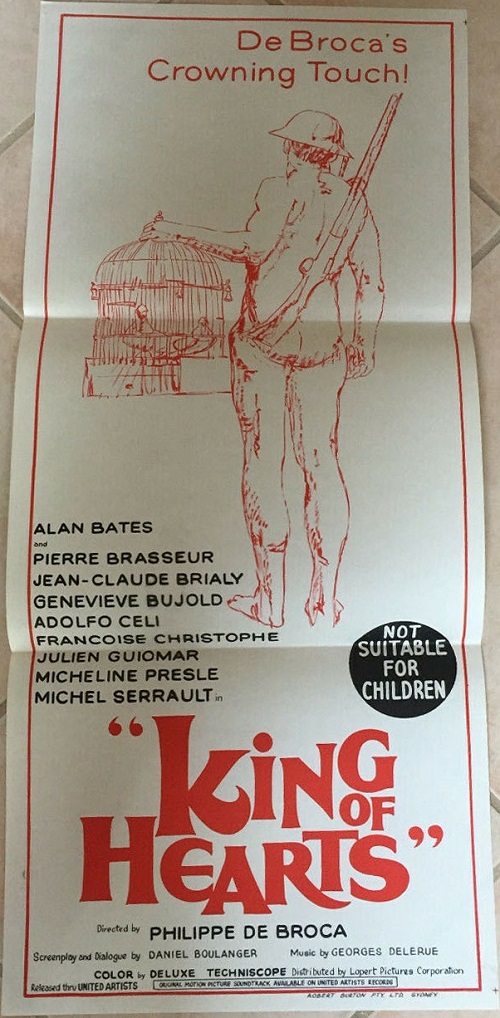 Australian daybill from the dubbed release of Sunday, 24 August 1969,
Australian daybill from the dubbed release of Sunday, 24 August 1969,
also distributed by Lopert. Image shamelessly stolen from eBay.
One of those revival screenings occurred when Boulanger/de Broca’s subsequent movie,
Give Her the Moon, opened in the US.
The Central Square cinema’s screen 1 in Cambridge, Massachusetts,
decided to double it with the earlier King of Hearts.
I would hazard a guess that this is what happened:
The Central Square preferred double features and, since this new movie was directed by de Broca,
management thought it would be a nice idea to pair it with one of his older films.
The cinema’s booker called the exchange and rattled off a bunch of titles,
and learned that the cheapest available was King of Hearts.
As far as I know, King of Hearts had not been shown in Massachusetts
since its initial run at the Cinema Kenmore Square, 11–29 October 1967,
its second run at the Harvard Square in January/February 1968,
and its third run at the Brattle in December 1968.
Since the print had been collecting dust at the local exchange for a little over two years,
it could by then probably have been rented for a mere $25 or $30 straight, no percentages.
I don’t think there was anything more to it than that, but that is only my guess.
The Central Square #1 opened Give Her the Moon on Wednesday, 10 February 1971, and then a miracle happened.
The second bill, King of Hearts, caught the attention of some students in the audience and they fell in love with it.
They told their friends and pretty soon the film was so popular that the Central Square dared not ship it out,
but kept it showing through Tuesday, 13 April 1976, a five-year-and-two-month run, during which time numerous prints were worn to shreds.
The locals had colloquially begun to call the Central Square “The King of Hearts Theatre.”
Word soon got around and, by 1973, King of Hearts was a staple
not just at a few US “art houses,” but at all of them.
With the establishment of the ratings system in late 1968, UA had no further cause to worry about censorship scandals.
So, UA phased Lopert out in 1969 and shut it down entirely in 1970,
though a few stray Lopert prints continued to circulate through about October 1971.
UA took over distribution rights to King of Hearts,
but refused to replace worn prints and planned soon to withdraw the film permanently.
(A booking at the Temple in Ithaca NY, for instance, had to be canceled because the print was no longer available.)
Fear set in.
The cash cow was about to be euthanized.
That is why a brand-new company was formed, The Film Group, Inc.
Here is an excerpt from that story, as published in History Link :
|
“I couldn’t survive long with a 93-seat theater,
not because people didn’t come but because I couldn’t get the movies....
With 93 seats, if I wanted a film I had to pay a booker in California $400 just to call somebody and break it loose for me.
I think everything else that has followed sprang from that,”
Finley told the Weekly in 1978.
Finley’s first major success came after he bought the rights to the French film King of Hearts
(Philippe de Broca, 1967) for $25,000 in 1973.
Finley developed an ad campaign and traveled the country offering exclusive rights to show the film.
Theater operators in New York, Washington, D.C., and Colorado each paid $25,000.
“I used the $75,000 to buy five new prints, and away we went,” Finley said.
King of Hearts eventually grossed over $4 million, of which Finley’s company kept about $1 million.
“You struggle and struggle and when you catch hot things you just ride them out,” Finley said,
“because you never know when you’re going get another hit.”
King of Hearts set the template for Finley,
who soon negotiated the rights to distribute Harold and Maude (Hal Ashby, 1971) in five cities.
Finley also distributed the 1939 film version of the Sherlock Holmes film The Hound of the Baskervilles starring Basil Rathbone,
which had an unexpectedly popular run after Finley developed an advertising campaign for it.
The Man Who Skied Down Everest, a documentary that Finley bought the rights to distribute,
won the Oscar for best documentary feature in 1975, although Finley said he didn’t make money on it.
The key, according to Finley, was all in the marketing.
“I’m basically a con artist, but I mean what I say,” Finley told View Northwest magazine in 1977.
“I stand behind the films I show.
People won’t turn out unless they know what we’ve got.
Once they’re in the theater, we want to knock their heads off.”
|
The Film Group, Inc., licensed US/Canadian rights for three years, January 1974 through December 1976,
and reissued the film with new prints beginning in early January 1974, preceded by two cartoon shorts,
Bambi Meets Godzilla and
Thank You, Mask Man.
I do not know what contracts led to that unusual programming.
My memory is that “Lopert Pictures Corporation” nonetheless still appeared, in small print,
on screen during the opening credits of King of Hearts.
(If memory serves, it was immediately beneath the censor visa, it bore a 1967 copyright, and it was clearly added by the lab.)
There was a new poster, similar but different:
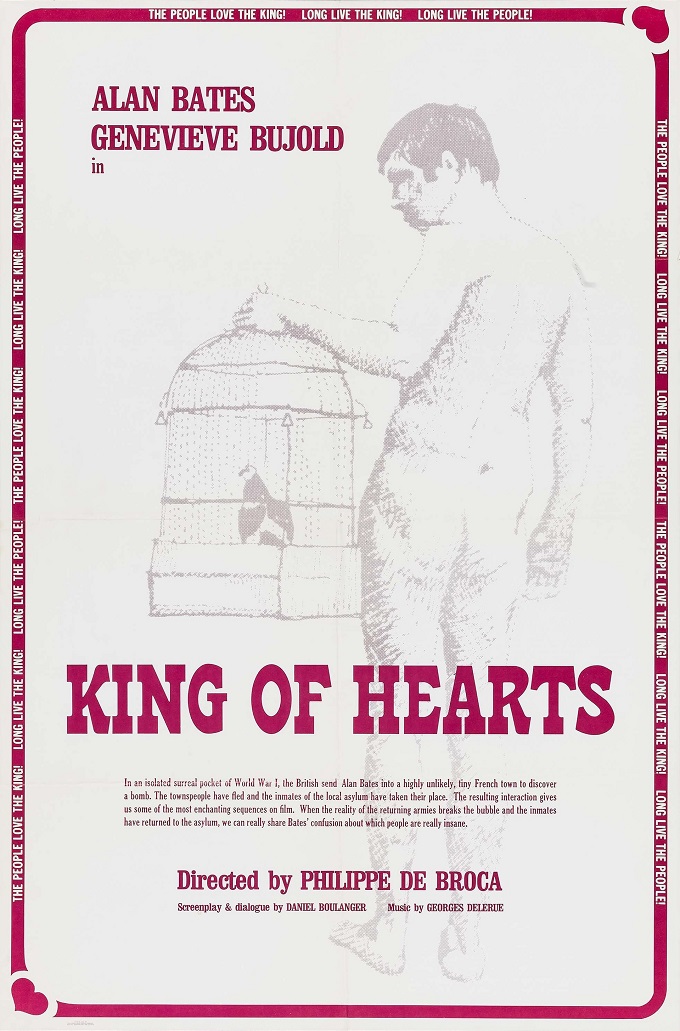
Poster for the 1974 re-issue by The Film Group, Inc.
It had printer’s errors.
First of all, only two of the cast members are named
(well, four, because scenarist Boulanger and director de Broca
also appeared on screen),
though, as we can see from the previous poster,
the contract required nine of them to be listed.
More strangely, The Film Group, Inc., neglected to credit itself!
I would love to know who created this poster.
You see, The Film Group, Inc., was brand new and its staff were still learning the ropes.
It was under the direction of brother-and-sister team
Randy and
Pat Finley, who ran a little arts cinema
in Seattle called The Movie House.
My guess (only a guess) is that the Finleys’ lawyer received a stern phone call from UA’s lawyer
who told them to set things aright or else.
There was a revised poster that corrected the original misprints.
All nine contractually obligated names were now included,
and “Distributed by The Film Group, Inc.,” was now clearly spelled out over Alan Bates’s ankle.
Here is that revised poster design:
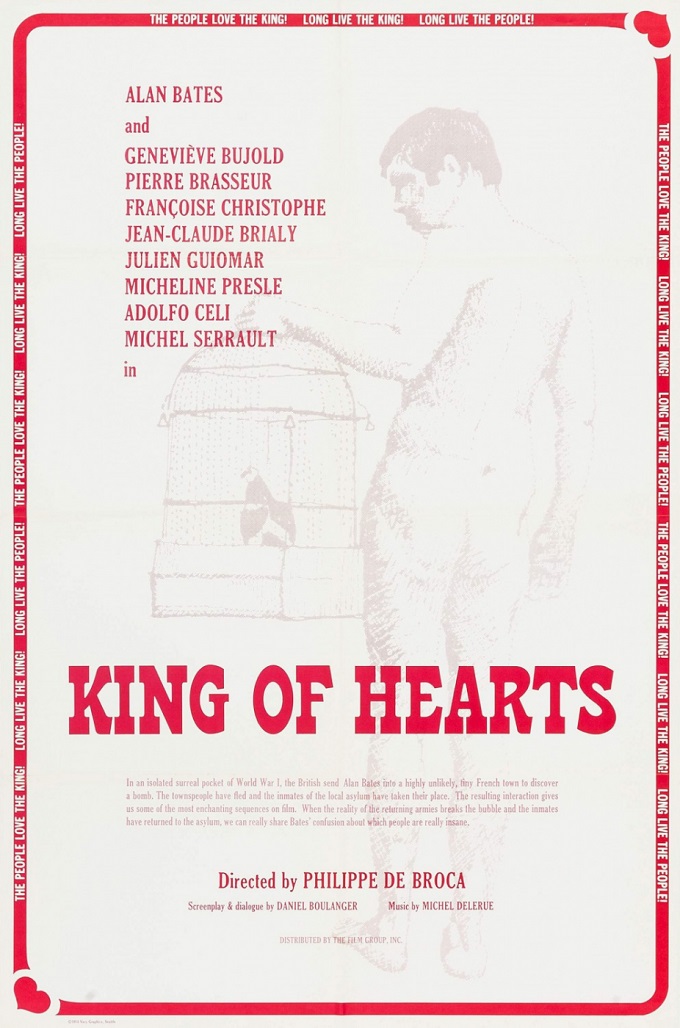
There was also a variant poster design, with the difference being the addition of a legend at the top reading:
“THE KING AND HIS LOYAL SHORT SUBJECTS: BAMBI MEETS GODZILLA — THANK YOU, MASK MAN.”
That is the poster that Don Pancho’s had on display.
I cannot find an image of that poster online, though I did find several pressbook variations on it, which you can see here.
In case you are curious, no, The Film Group, Inc., did not submit the film to the MPAA CARA for a rating.
It was unrated.
Age restriction was left up to the individual cinema management.
In Albuquerque, there was no age restriction at all.
In other places, though, a number of cinemas told lies, as you will soon discover.
Shall we learn a little bit about The Film Group, Inc. and its strategy?
I think we should.
You see, were it not for The Film Group, Inc., we would likely never have known about King of Hearts.
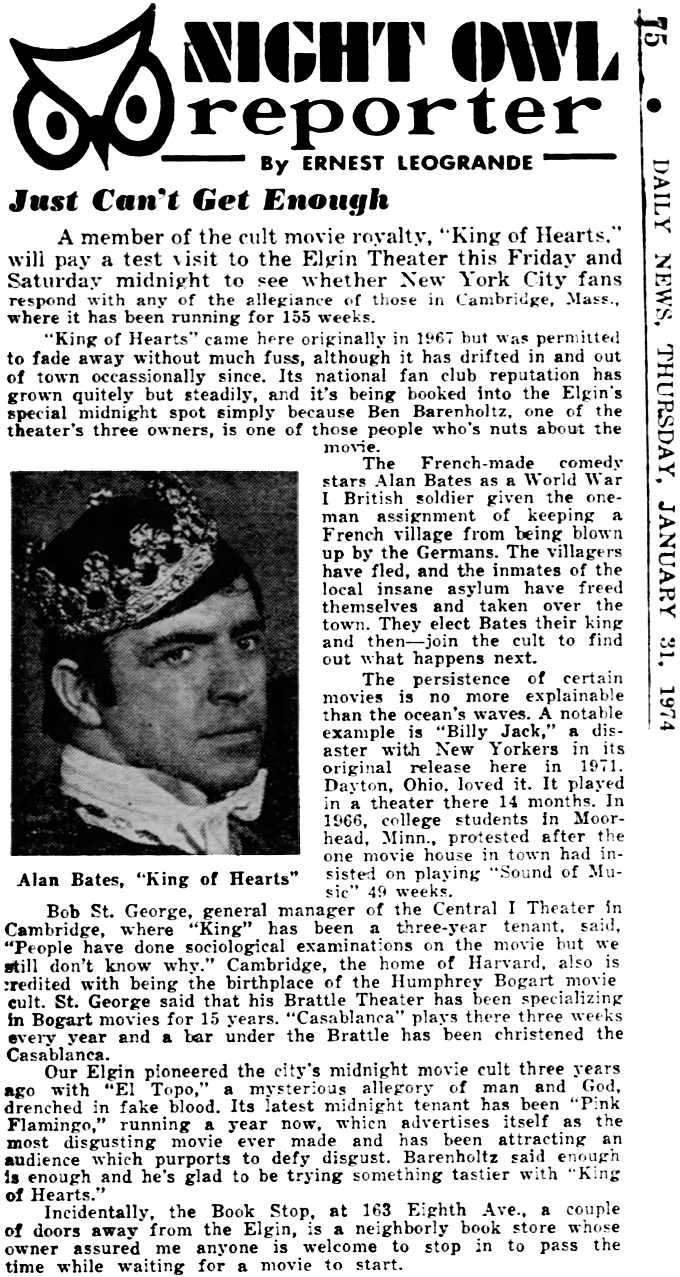
“Permitted to fade away without much fuss.”
And what else is new?
Nearly ALL movies fade away without much fuss.

There were several editions of the Detroit Free Press that day, and this was in at least one of those editions,
but definitely not in all of them.
Ross Caccavale? Ross Caccavale? Ya gotta be kiddin me.
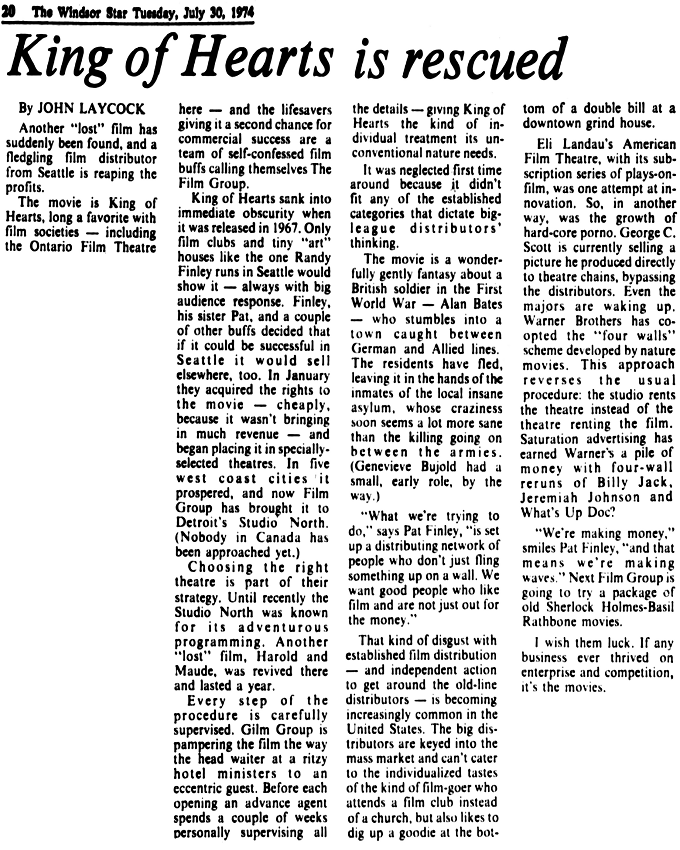
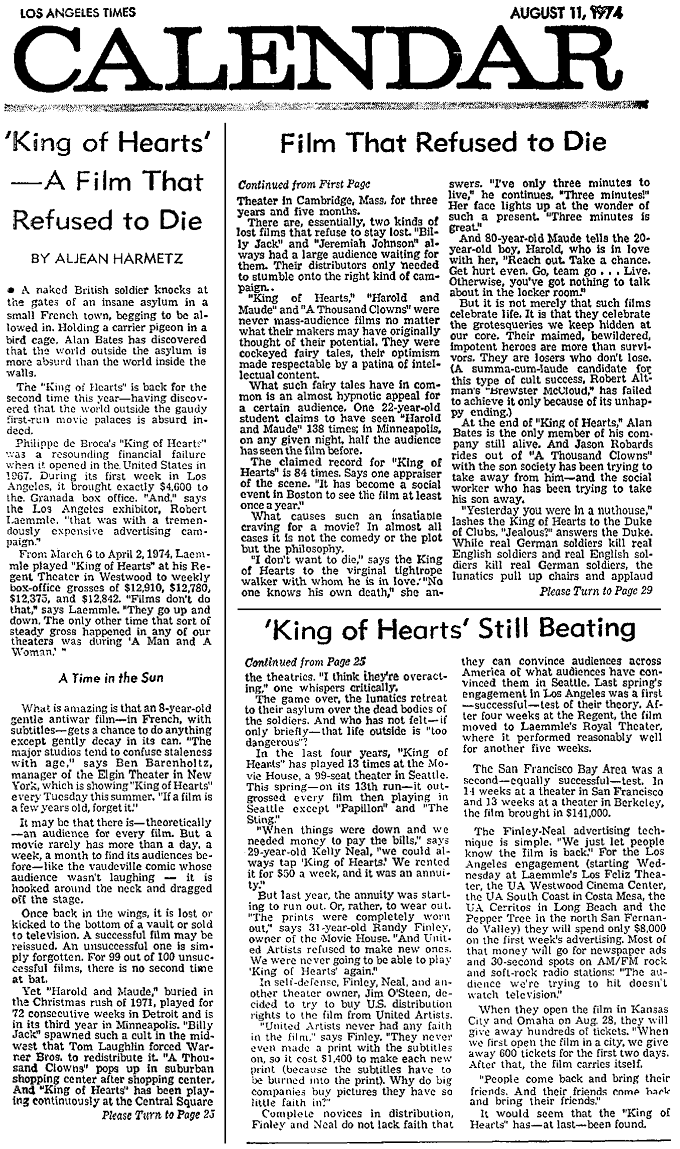
The above article makes its point about King of Hearts having been “a resounding failure” when it opened in the US in 1967,
and, to demonstrate that point, makes mention of the paltry receipts at the
Granada in West Hollywood.
As we learned above, King of Hearts had a limited but healthy long run when it opened in the US in 1967.
Why did the Granada do poorly?
Let us check.
The Walter Reade Organization chain opened the Granada on Tuesday, 15 August 1967,
and the Granada’s
first offering was King of Hearts.
Now, this film was attractive pretty much only to the college and bohemian crowd.
The cinema sat 379 and it was not in a college or bohemian area, but in a
commercial district, across the street from a strip joint, not where bohemians would want to be, ever.
The ticket prices were not advertised, but as far as I know, apart from roadshow engagements,
movie tickets were $1.00 in and around Los Ángeles in 1967.
So $4,600 for one week would be 4,600 tickets.
There were three shows every weekday, five shows each Saturday and Sunday, for a total of 25 shows per week.
That is a potential of 25×379=9,475 tickets that could be sold each week.
So, that’s about 48% capacity, each showing, on average, which ain’t bad at all!
Rare was the cinema that performed so well.
King of Hearts played at the Granada through
Tuesday, 19 September 1967,
a five-week run.
Box-office failures generally did not continue their runs for five weeks in 1967.
The $4,600 is contrasted with the $12,910 for the first week of the revival at the 400-seat
Regent in Los Ángeles
beginning on
Wednesday, 6 March 1974, which also had 25 shows per week.
Not such a fair contrast.
The Regent was in
a much more walkable neighborhood, considerably more inviting to bohemians.
By 1974, ticket prices were $1.75 in the general Los Ángeles area.
Shall we, as they say in Albuquerque, cackle-ate?
Potential sales: 25 shows × 400 seats = 10,000 tickets.
$12,910÷$1.75=7,377 tickets sold.
Average capacity: 74%.
Much better, but not worlds better.
Further, the film had established a solid reputation over the preceding six+ years and had even become somewhat legendary.
We’re not getting the whole story.
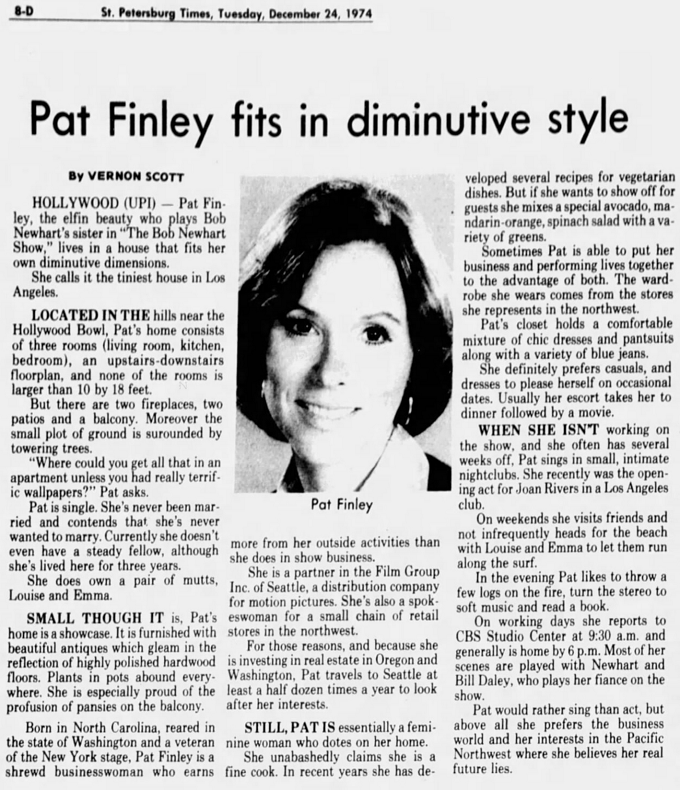

The Film Group, Inc.’s, license expired at the end of 1976.
Actually, I think that The Film Group, Inc., itself expired at the end of 1976:
United Artists, belatedly recognizing that it had a goldmine on its hands,
assigned the film to its new art-house subsidiary, UA Classics (formed in 1975, I think),
and made new prints for a new release, which began, I think, Wednesday, 4 January 1978.
The new poster reverted to something nearly identical to the original design:
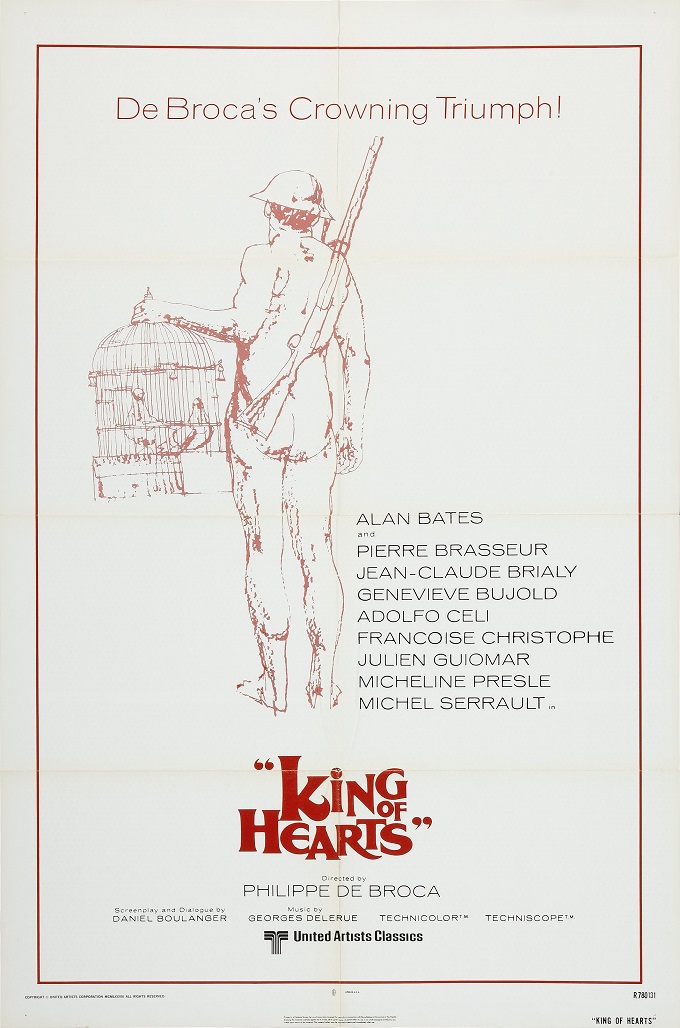
It is unfortunate that, in addition to the subtitled edition,
there was also an English dub, right from the start.
The dub was the edition that Lopert exported to
Australia in August 1969.
It seems that this English dub was booked in
Milwaukee in August/September 1967, in
Ithaca in September 1967, in
St. Louis in October 1967, in
Chico in May 1968, in
Pittsburgh in September 1969, and in
Fort Lauderdale in May 1973.
Even when The Film Group, Inc., licensed the rights, it, too, made new prints of the English-dubbed edition,
one of which played in
Bennington in May 1976.
I never saw the English dub.
If I ever get the chance, I guess I shall watch it, but I’ll be cringing all the way through.
I’m certain it’s horrid, but I am curious about any clues it might contain.
When King of Hearts was
first issued on VHS and Beta in this country
in or just before August 1981, by
Magnetic Video Corporation
(which at the time was owned by 20th Century Fox), licensed from UA,
it was pan-and-scanned and at least some copies were dubbed into English.
I found the idea so revolting that I refused even to look at it.
Now I regret not having purchased the tape.
Apparently, that exact same transfer was also issued on
a 20th Century Fox CED (Selectavision) disc the following year.
RCA released a CED Selectavision disc
(RCA 01480) in July 1984,
allegedly letterboxed, which would have been highly unusual for a CED release, and, I presume, dubbed into English.
There was also a laserdisc from Warner Home Video (NJL-99724) in Japan on 23 February 1991, pan-and-scanned,
dubbed entirely into English, with Japanese subtitles.
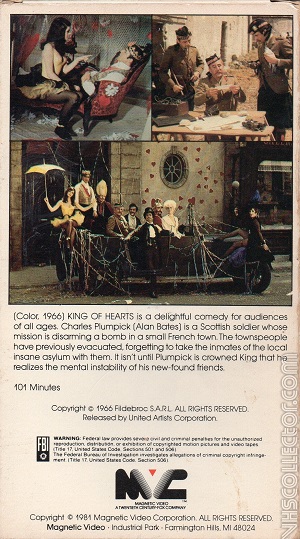

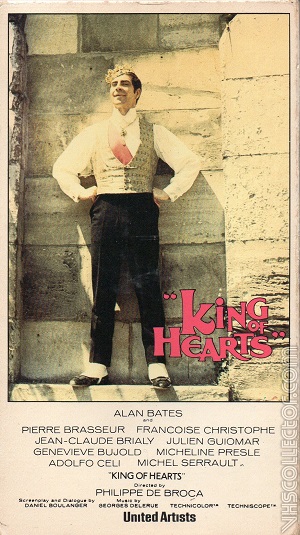
I would love to know who designed this box.
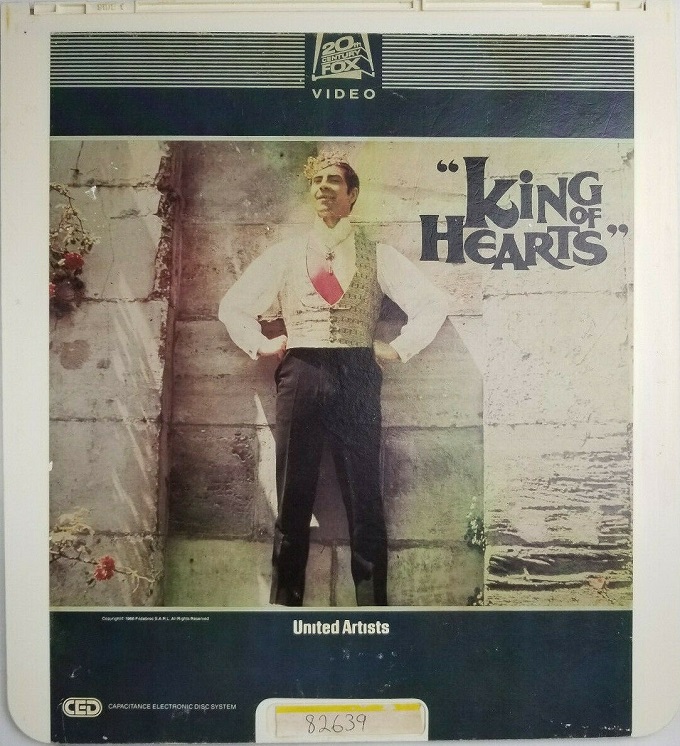
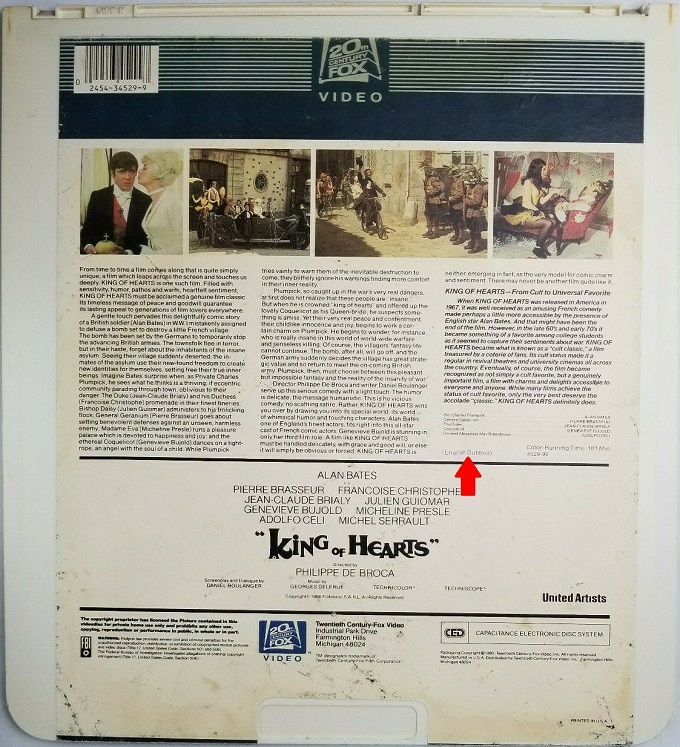
The CED (Selectavision) of the dubbed edition, from 20th Century Fox.
Images blatantly stolen from an eBay listing.
I would love to know who designed this caddy and who wrote the text.
When I saw the movie on cable TV in about 1985, I was horrified.
It was pan-and-scanned and it was entirely subtitled.
Even the English-language scenes were subtitled, but the subtitles were based on a French translation,
and were not transcriptions of the actual dialogue!
Apparently, the people who submitted the subtitles based their work on a French-language transcript,
and never bothered to watch the movie.
Why am I not surprised?
I still have that monstrosity in storage somewhere.
Oddly, in release after release after release, at the cinemas and on video, we see the identical mistakes.
There is a brief English-language moment that has a French translation in voice-over.
(That’s at 0:32:00 on the
Masters of Cinema Blu-ray.)
If the English dub contains that line unaltered, then it could be used to restore the original.
Also, there are several day-for-night shots
for which the lab personnel neglected to insert the blue filter when making the interpositive.
Nobody ever bothered to correct those latter mistakes until the recent Blu-ray.
And why were those mistakes corrected?
Because cinematographer Pierre Lhomme himself oversaw the transfer!
Bless his heart!
By the way, the film was two minutes longer when it premièred in France.
I had sort of expected the 1990
Criterion laserdisc to include those missing segments, but it did not.
I never saw the
RCA Selectavision CED or
Warner Home Video laserdisc,
and so I have no idea which versions they were or how complete they were.
When the film was first issued on
DVD in this country, on Tuesday, 10 April 2001, by MGM, at last, it was complete!
Monseigneur Marguerite has an extra few lines and there is a brief epilogue.
MGM uttered not a peep about any differences and do you want to know why?
That was simply because MGM grabbed a different master (probably from its Paris office)
and had no idea that it differed from what American audiences had seen before.
When I saw a new 35mm print at Grauman’s Egyptian on Sunday, 11 October 2009,
it, too, was complete, identical to what I had just witnessed on DVD.
I suspect that it was de Broca himself who had made the slight deletions in 1967,
since they are so well made, but I do not know for certain.
The abrupt ending with Bates standing in front of the gate is brilliant, defiant, uplifting.
The epilogue, inside the hospital, is wonderful and beautiful, but painfully sad.
The women and men are caged in different rooms.
The women look wordlessly through the bars at their men.
The queen is locked away from her king.
The duke gives voice to what was only implied over the past two hours:
The inmates are not crazy; they intentionally chose to live in a fantasy rather than in reality.
The duke’s beatific expression falls and becomes morose in the split second as the image fades out.
His words, which at first seem like homily, prove to be dogma.
I cannot make up my mind which ending works better, though I can say that each ending creates a different overall feel and mood.
The prior US prints had a brief credit roll at the end, which my memory tells me was in French and looked to me like an American add-on
(and I think it was deleted from the 1990 VHS from MGM/UA).
If my memory is correct, it was only a few seconds long, ten seconds at most.
If memory serves, the edition on cable TV had the end credits in English.
The MGM DVD from 2001 was taken from a print that never included the credit roll at the end,
but that had, instead, a simple title, “FIN,” which I had never seen before,
and which seems to be about as long as the brief credit roll that I remember.
The “Masters of Cinema” Blu-ray has the end credits in French,
and, if my memory is correct, they seem to be considerably longer than what I saw in 35mm.
The Blu-ray does not have “FIN.”
Why are there so many variations?
What is most authentic?
I should also say that each release had freshly translated subtitles.
My memory is that the print from The Film Group, Inc., which I saw in April 1975 and again at the end of 1976,
had much better subtitles than anything issued since.
Why do I tell you all this?
Simple.
I tell you all this so that we can get to the punch line.
In November 1976, Donald Pancho’s must have been hurting for funds,
and so booked King of Hearts for a four-week run,
26 November through 23 December.
I attended four Saturdays in a row to see the matinée screenings.
At the time, the film was still under the control of The Film Group, Inc.,
and Movie, Inc., submitted an ad snipped from the 1974 press book, but something happened.
I saw the newspaper that morning and I assumed that somebody at Movie, Inc., had altered the advertisement.
Nope. It was the newspaper that had altered it.
When I arrived in the lobby, on Saturday, 27 November 1976, the phone rang.
Mark Brown answered.
It was a staffer who was calling to tell him what the newspaper had done.
Mark said that was “hilarious,” and then he passed on to the two or three other people in the lobby that strange news.
What did Mark find hilarious? This:
Every good punch line deserves a topper. So, here is the 1967 Italian poster:
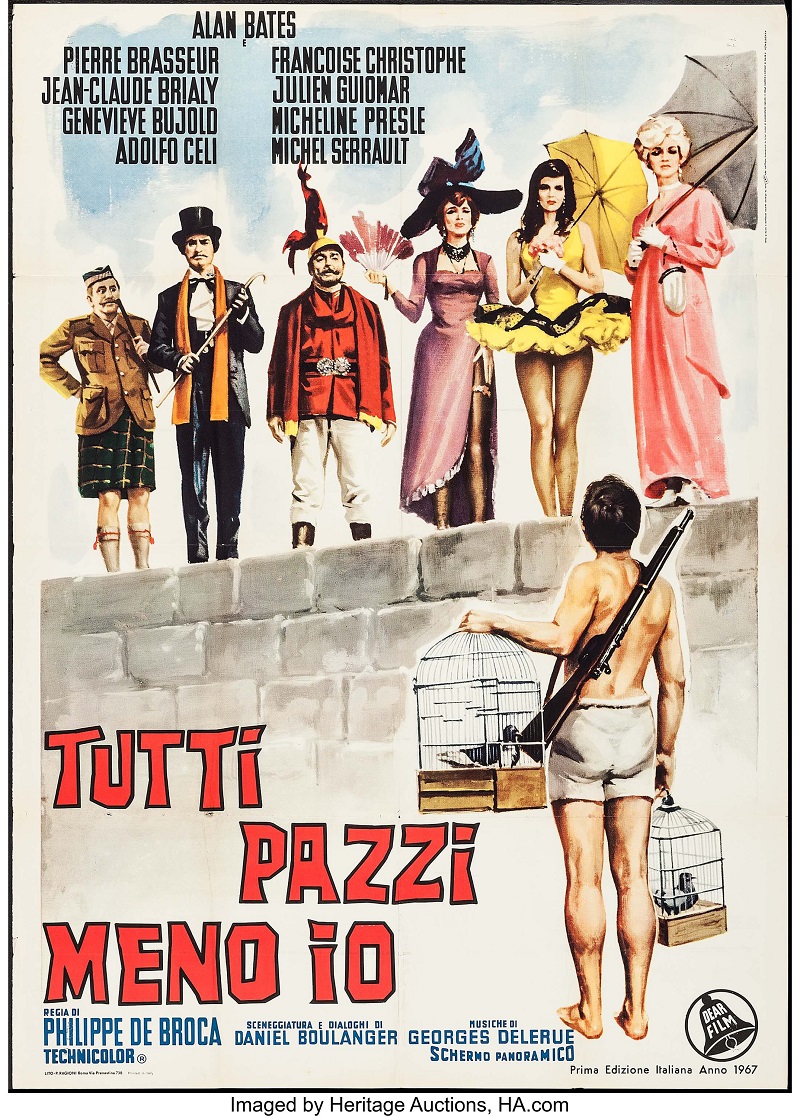
I would love to know who created this poster.
And then, well, just because, hey.
Even that was nothing new. Here was the ad for the US première, clipped right from the pressbook:
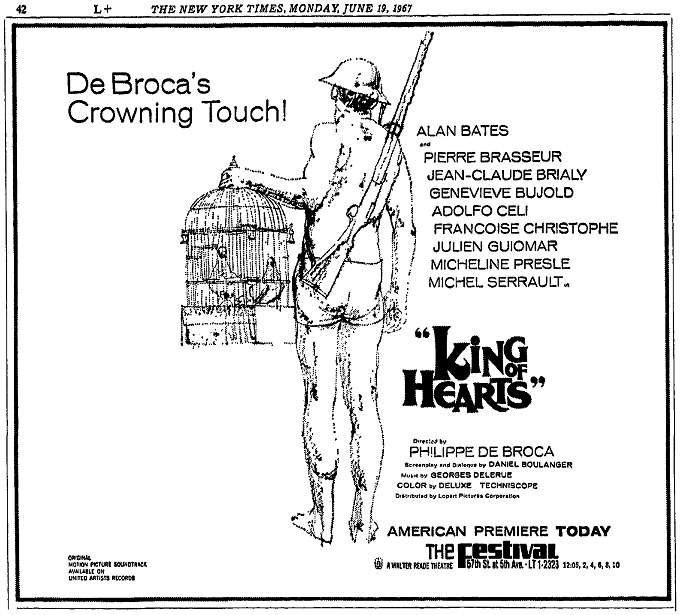
Oh, heck.
I should add another trivial note
of no consequence to world events, global climate shift, soil erosion, poisoning of oceans, or anything else like that.
Donald Pancho’s had generally projected anamorphic films with .715"×.715" apertures,
rather than the more proper .715"×.839" apertures,
which were not in the inventory and which would have overfilled the screen
with the lenses that were in the inventory and was thus losing a tremendous amount of the width.
I think it was on my third Saturday of King of Hearts (11 December 1976)
that I recommended that projectionists use the undercut .650"×.775" apertures instead.
There would be some loss in height, but a fair gain in width.
As has almost never happened ever in my life, before or since, people took my advice.
By the time I saw it that fourth Saturday, it looked significantly better!
The height actually needed to be cropped, because there had previously been frameline flashes,
and the framing varied from shot to shot.
In half the shots there was a the tiniest sliver of the bottom of the image at the top,
or, if framed differently, in the other half of the shots there was the tiniest sliver of the top of the image at the bottom.
It really needed to be cropped slightly, maybe to .705" in height.
One other trivial note of no consequence to mass extinctions or ozone depletion or water rights on reservations or mandatory sentencing:
It must have been sometime in 1977 or early 1978 that I was in the booth at Donald Pancho’s,
and Ernie showed me a letter that Movie, Inc.,
had just received from United Artists or some subsidiary thereof or possibly an exchange,
warning of the sorrowful condition of the print of King of Hearts that was on its way over.
Stapled to the letter was a small sample, I think three frames (an early scene with Adolfo Celi), of the damage in evidence throughout:
Every sprocket hole had popped and every sprocket hole had a rip that tore almost right into the next sprocket hole.
Apparently, a projectionist had not lubricated the gate or the print,
and had run the green print on a projector that had Foxhole CS sprocket teeth —
and surely no longer had Foxhole CS sprocket teeth after battering that print.
How on earth would anybody possibly be able to project this?
I did not attend that scheduled showing of King of Hearts, nor did I ever ask how it went.
Now that I have blathered on and on and on and explained to you more than you ever wanted to know about King of Hearts,
I realize something.
You see, to write this side note, I needed to dig through old newspapers and various postings online,
and that is how I learned that everybody who has written about this movie has misunderstood it.
That is depressing.
So, I guess that King of Hearts was a failure, after all.
A successful story is one that is widely understood.
Yes, I agree that it is anti-war;
yes, I agree that it does touch upon the nebulous concept of sanity;
yes, I agree that the film is gorgeous to look at;
yes, I agree that the music (much of it based on the clock’s chime) is seductive;
yes, I agree that the story is enchanting, funny, sour, sad, uplifting.
Yet, NO, I most definitely do not agree that it argues that lunatics are sane and that the rest of us are nuts.
That is a facile misreading and it is not the message at all.
Some commentators and critics have pointed out that the characters in this film are caricatures
and that the events in it are impossible.
That is to miss the point.
The characters are not caricatures; they are archetypes.
The events are impossible, yes, just as they are impossible in Rip Van Winkle or Rumpelstiltskin,
but I never hear anybody complain about Rip Van Winkle or Rumpelstiltskin being impossible.
The theme of the story is play, as in the play in which infants and children engage, and also play as performance.
Correlative to that is the derealization that inevitably arises from any sort of play.
Why do people conclude that Madame Eglantine and Monsieur Marcel and Monseigneur Marguerite and a few of the others
just whimsically assume their characters?
No, they do not assume those characters.
They resume their characters!
Those were the people they actually were prior to being locked up.
That’s how they know where everything is stored.
The musicians had certainly been musicians before their incarceration!
Why has nobody noticed any of this?
HOW has nobody noticed any of this?
I read all the customer comments posted on Amazon and I think a few of them are worth reproducing.
Remember when I mentioned that this film is trilingual?
The French speak French, the Germans speak German, the Scottish speak English,
and most people cannot understand the other two groups.
That is a vital plot point.
|
Frank
Wasted $$$you.
Amazon says the audio is English but watching the first 10 minutes, it is in German and French with English subtitles. Also, a period film set in WW1. Wasted $$$you.
|
|
corinne magarian
film not in english
it is not in English! subtitles only. Am I missing the English part? please let me know if I am. thanks
|
|
Novel Lover, Ph.D.
French film (in French) released in 1966--NOT in 2018 and NOT in English!! A total rip-off.
Buyer beware:
(1) This is a French film, by Philippe de Broca,
therefore predominantly in the French language with bits of German and English.
All the main actors are French plus Alan Bates.
(2) It was NOT released in 2018, but in 1966 (France) and in the US in 1967.
There is no way to know this until after purchase, that is,
if you trust the Amazon Prime Video description and don’t do any outside research first.
And, (3) even if you are a French-speaking francophile, it isn’t all that great....
|
|
scott p clark
2 movies in one
I first saw this in a theater in 1969.
My recollection is that the movie I saw had English dubbed in for the French and German dialogues.
This has English subtitles so a lot of the subtlety gets lost....
|
|
Robert Bradbury
No Dubbed English Soundtrack for DVD and Blu-Ray
Do NOT buy either the DVD or the Blu-Ray versions of this movie.
Neither is in English!
French language only with English subtitles!
The commentary audio is English however.
It is difficult watching a movie and having to read subtitles.
Despite the English language claims for the DVD and the Blu-Ray-- taint so!
I now have two Cohen Films I can’t enjoy!
Avoid these if you aren’t fluent in French. Big big let down!
|
Remember what I mentioned about the original December 1966 French version being two minutes longer than the versions originally shown in the US?
|
Kindle Customer
Is there something extra on this DVD?
King of Hearts was, in my younger and more vulnerable years, one of my favorite movies, but I had not seen it in many years.
In fact, I’d rather forgotten about it.
Then I came across the DVD and bought it and watched it again.
Still a great movie, but I was puzzled.
My recollection was the final scene of the movie is Plumpick (Alan Bates) appearing at the gate of the asylum naked.
Then the credits began (rather abruptly as I recollect).
In the DVD, however, there is a short scene after this where Bates has joined the inmates
and there is a brief exchange of dialog.
I don’t recall ever seeing this before, but maybe my memory is foggy.
No one else seems to have mentioned this either in ... of IMDB, nor does the DVD tout a restored scene.
Can anyone tell me if they recall this scene?
|
|
Geneva Hagen
Add-on?
I, too, remember this as one of the all-time great movies.
Reviewer John Robinson is right:
The American theatre version stops with the hero standing at the gates of the city with a bird cage; there is no further dialogue.
The French film tradition does not wrap stories up into such tidy packages as Hollywood does.
Perhaps the American version of the film was cut to give it a more clearly defined finale....
|
|
R.L. Holly
Enchanting fantasy; topical allegory; classic movie
Quelle Surprise!
This DVD version has, without fanfare, at least two entirely new scenes in the film that I have never seen before
(and I first saw this in 1977).
The first is a lengthier “homily” by Monseigneur Marguerite (aka Bishop Daisy)
in the church before Charles’ coronation.
But the real grabber is an added scene at the very end of the movie that offers a parting glance at the primary players
and a final bittersweet twist.
Where on earth did this footage come from, and why has it been missing from this film for so long?
Does this DVD version offer a “better” ending than the familiar one?
It’s debateable.
But it’s certainly intriguing.
|
|
Robin H
Incredible movie, poor DVD version
This has always been one of my favorite movies, and I reluctantly shelled out big bucks to get a copy of the discontinued DVD version.
Everything about it is GREAT, absolutely perfectly transferred,
but the SUBTITLES were CHANGED in a number of scenes from the original theatrical & VHS release subtitles.
The unpleasant result is less humor & less unique character development in several instances.
It really detracted from my enjoyment of the film.
Anyone who has been a repeated viewer of this movie should notice this, yet I haven’t seen it mentioned in any reviews.
Also translating Cocliquot’s name (sorry about misspelling) to POPPY seems almost tacky to me.
Finally, I could have done without the additional 57 second final scene inside the asylum;
TKOH is an ANTI-WAR FABLE; the original ending (which I saw in theatres 30-odd years ago)
of Bates naked at the gate is both appropriate & metaphorically in line with the message of the movie.
Presentation of his actual life inside the asylum is absurd & off the track.
Still, apparently De Broca kept this scene (although not in theatrical release)
so DVD is worth having in order to have it, if you are a die-hard fan.
Get the 1990 VHS release is my recommendation for a duplication of the original theatrical experience.
|
|
James D. Sigrist
the film is great but..........
King of Hearts is one of my all time favorite movies.
This review is specifically about this movie on this VHS release.
Everything is fine as far as the print quality, subtitles and all of that.
What is unfortunate is that the ending of the film is abruptly cut off just as the theme music comes in on the last, final scene.
It’s a lovely moment too.
The final period to absorb the magic of what you have just seen is chopped off
and in its place comes the gaudy, probably ’80’s era MGM logo routine with extra loud and annoying music.
All credit details are gone as well.
How a company like MGM could do something so poorly is beyond comprehension.
Pure schlock.
This is a great movie but you are better off with any of the other releases.
It’s still MGM, but the movie was remastered for DVD and this mistake was fixed for that release
and the VHS released at the same time.
Time for a major Criterion release of this most magical of films.
|
|
Roberto
We enjoyed the movie
We enjoyed the movie, a blast from the past.
but this wasn’t exactly the one that I saw in the sixties, which was a little more subtle.
|
Remember above when I mentioned that the original 1981 VHS release and the cable-TV version were pan-and-scanned?
Below we have a comment from a guy who had a problem and, now that I checked again, I see what he means.
The transfer was letterboxed, but it was not optimized for 16×9,
which results in a tiny rectangle in the middle of the screen.
The colors are bad and the resolution is low, too.
|
Samuel
High energy, garish chromatics, an autonomous world almost to the end.
...The present DVD copy retains all of the color of some of the better technicolor prints of the ’50s
(many ’60s and ’70s films show their age due to fading or iridescent chromatics);
the images are quite sharp;
the monophonic soundtrack is sufficiently resonant and festive.
The aspect ratio is somewhat of a disappointment:
3 of the ratios are distorted or poorly fitted to a 16:9 screen;
the “right” one uses only half of the total screen space.
It’s a neat little film, but much of its success goes beyond plot,
offering in its place an alternative cinematic world for the spectator to find a place in.
It’s due for a resized, remastered Blu Ray edition—if it could be so fortunate
as to find present-day applicants for the asylum.
|
|
Fellini8
The King of Hearts
...However, PLEASE NO LETTER BOX.
The 10% or so gain in screen width is more than offset by the loss of the whole movie in terms of clarity and intimacy.
|
Just to make it nice and sparkling clear:
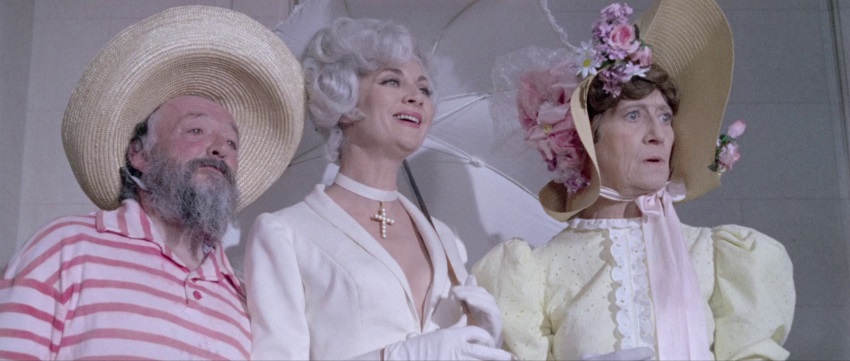
Above is a frame grab of the original, as intended to be shown at the cinema.
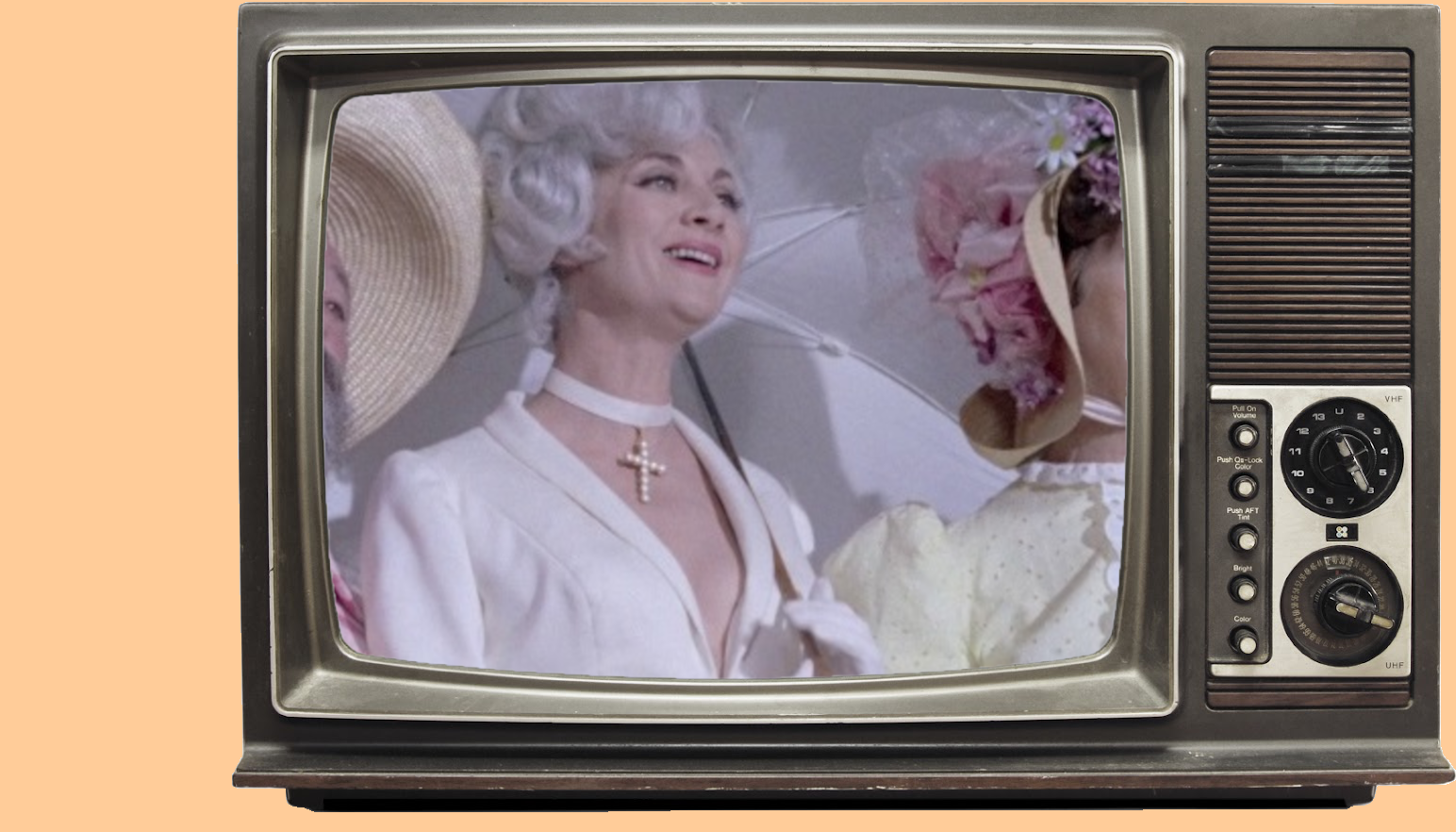
Above is how it would have displayed on your old TV set.
So what’s all this about a marginal “10% gain”?
Remember when I mentioned that the credit roll at the end is not included in all the prints,
and that the end music was once much shorter?
|
Sam
movie is great, DVD sucks
The sound quality of the DVD left much to be desired and there were no credits after the movie.
Sorry, but I’m one of those people who likes to sit through ALL the credits when a movie ends.
|
|
paulbergsman
King of Hearts, DVD
This was an excellent movie. But, unless you like reading sub-titles, don’t buy this DVD.
I own a old VHS copy of the KING OF HEARTS.
The audio track is in English.
For some unknown reason, the DVD has a French audio sound track.
And, only a French audio sound track.
I saw the movie many years ago and the sound track was in English.
Several months ago, the movie was on PBS, IN ENGLISH.
The VHS is in English.
So, why did the studio release the DVD in French?
To make matters worse, most sellers us an old discription which says there are sound tracks in both French and English.
My seller was great.
He allowed me to return it for a full refund. But, he has not changed the listing’s discription.
If the studio comes out with a revised version which includes an English sound track, then this is a must have DVD.
It’s a classic, timeless, anti-war movie.
It is as enjoyable today as it was 40 years ago.
Until then, find a good VHS copy.
|
I just found an essay
by a guy who dislikes pretty much everything about the movie.
Underneath his essay is a comment from a Keith Enright:
|
You asked me a few months ago when I bought the LD to give you my thoughts when I got around to watching it.
What a mess.
This movie made me mad.
Every character a cipher, every emotion unearned, every plotpoint forced, tone deaf slapstick,
and the worst day for night photography I’ve ever witnessed.
I agree this might strike a cord in 1970, but today this is just inert.
Other than that it was fine.
|
All in all, I am reminded of the time when I was 15, when I mentioned to another kid my age that I had recently seen and enjoyed King of Hearts.
His immediate bullying response: “Oh that was stupid!!!!! It was all in German!!!!!”
As we all know, UA was gobbled up by MGM, purportedly because of Heaven’s Gate, but if you believe that story....
Then Sony gobbled up MGM/UA.
Whatever happened to Compania Cinematografica Montoro, I do not know,
but somehow its rights were obtained by Studio Canal.
According to DVDClassik,
the 4K restoration from 2017/2018 came about only because the de Broca family
purchased MGM/UA/Sony’s and Studio Canal’s shares in the film.
I congratulate the family for doing that.
The de Broca family then licensed the cinema and video distribution rights to
Charles Cohen.
The Blu-ray looks stunning, though it does contain some refractions that I do not recall seeing in 35mm.
Why does it not include the English dub?
Well, take a wild guess.
I bet that the de Broca family members object to the English dub and if that is the case, I can hardly blame them!
I am willing to bet that Philippe de Broca had nothing to do with the English dub and, if he ever listened to it, he probably hated it.
Watching the movie again makes me realize that the casting was perfect.
Nobody, but nobody else could possibly have portrayed any of those rôles even half as well.
Their faces, ALL their faces, absolutely fit their childlike characters.
How I wish I could identify the actors who dubbed the Scottish troops!
This is the movie that convinced me to watch everything with Alan Bates.
I pretty soon abandoned that endeavor.
The King of Hearts is the one and only rôle he was born to play.
The other rôles were just gigs, nothing more.
|
My father wrote the original short story
I can honestly say I got the film when I was 7 years old.
That’s because I had the person who wrote it sitting right next to me.......... my father.
He was heavily anti-war, and wrote it as a short story while at Harvard Business School.
He sold the rights to it in order to help pay for his tuition (He got $500 back in the 60’s).
I still have the original manuscript stored away in my apartment.
He named one of the main charachters, Coquelicot, after one of his favorite Monet paintings.
He always had a large print of the field of poppies up in his house.
When he died last year, that and the short story (the original name for plumpick was pumpick), were the first things I looked for.
Even though his name isn’t credited, I always have this film to remember him by.
|

Claude Monet, Les coquelicots, 1873.
I sent jsmick-2 a message via IMDb some years ago, but he never responded.
I still do not know who jsmick-2 is.
It would be of monumental importance to recover that short story.
On the off-chance that you actually read this chapter,
how will you react the next time somebody explains to you that King of Hearts flopped in the US on its first release and that it got horrid reviews?
There’s a lesson in there.
If, for absolutely no reason at all other than the sheer malicious joy of telling public lies,
people can misrepresent such inconsequential matters as the popular reception of a movie or its gross and net earnings,
can you imagine how badly local news and world news is misrepresented?
Text: Copyright © 2019–2021, Ranjit Sandhu.
Images: Various copyrights, but reproduction here should qualify as fair use.
If you own any of these images, please contact me.
|
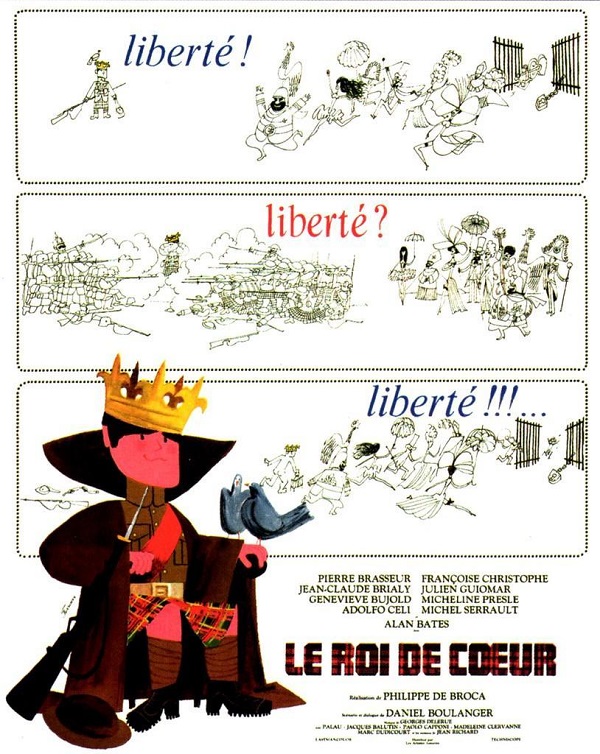
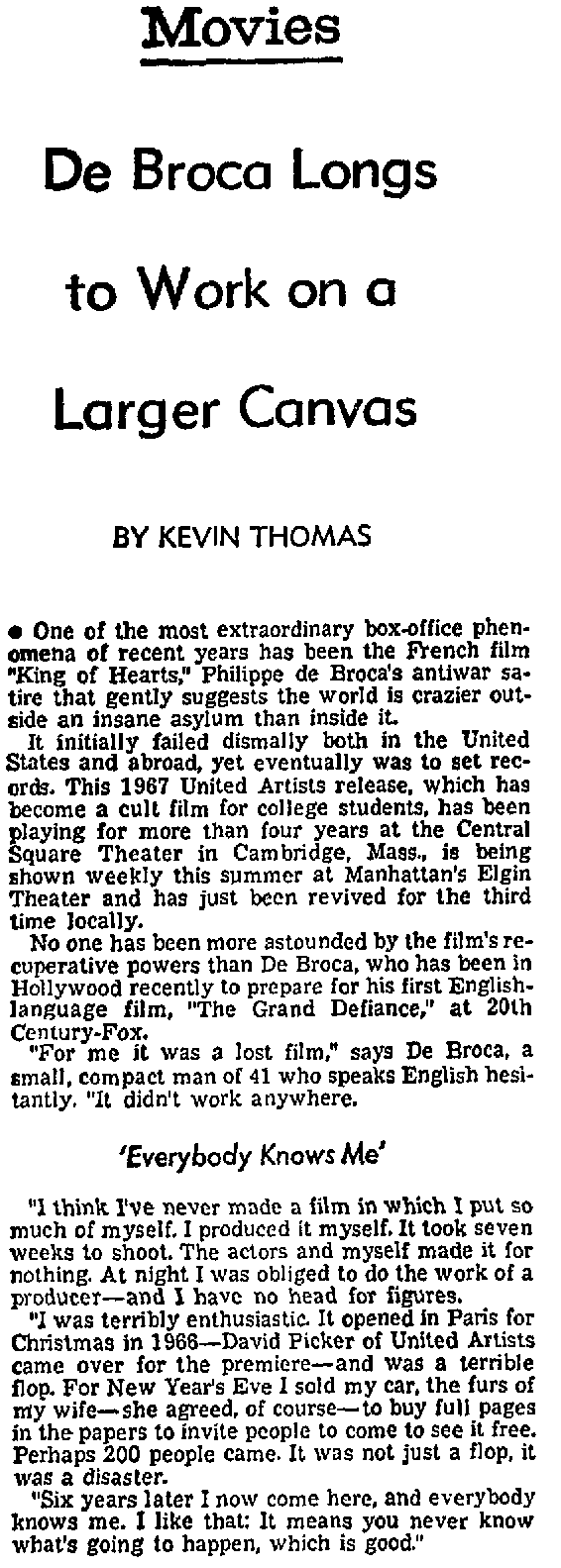
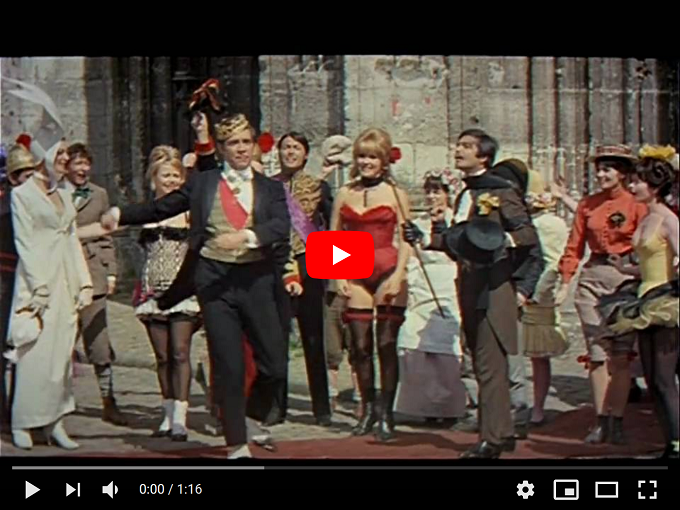
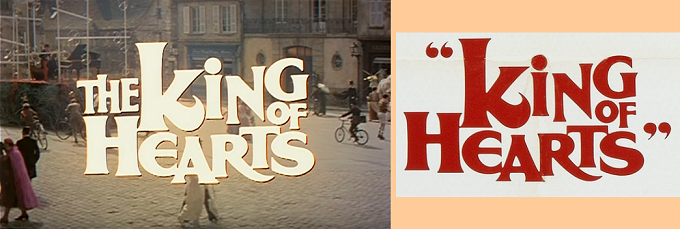
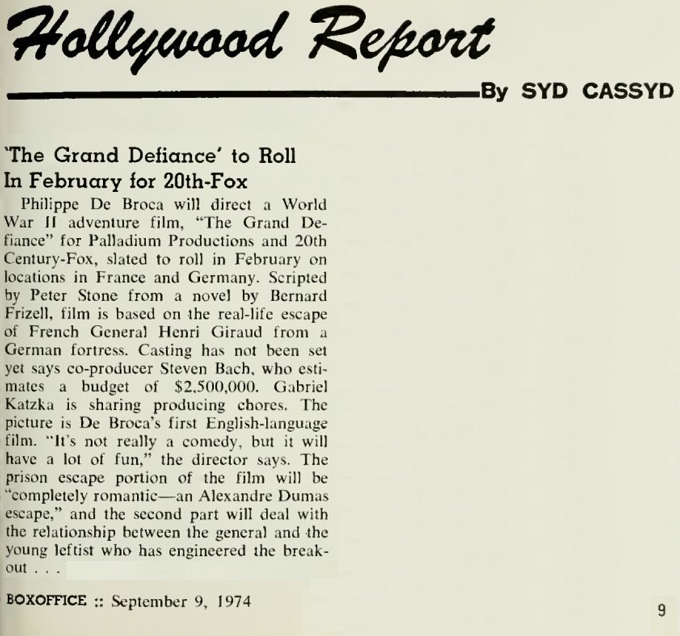
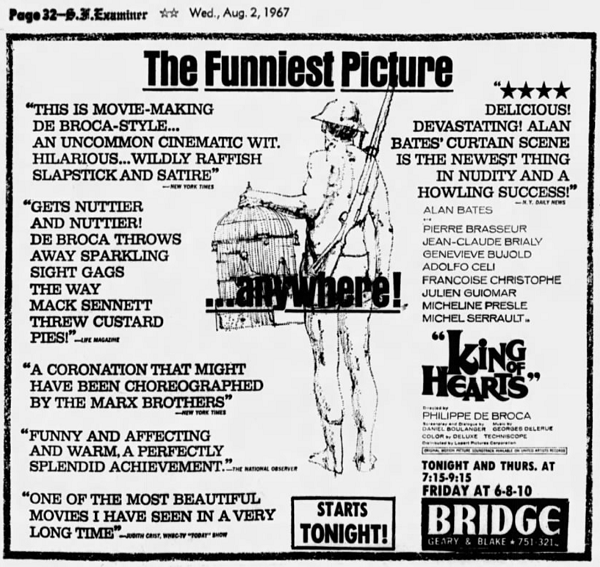
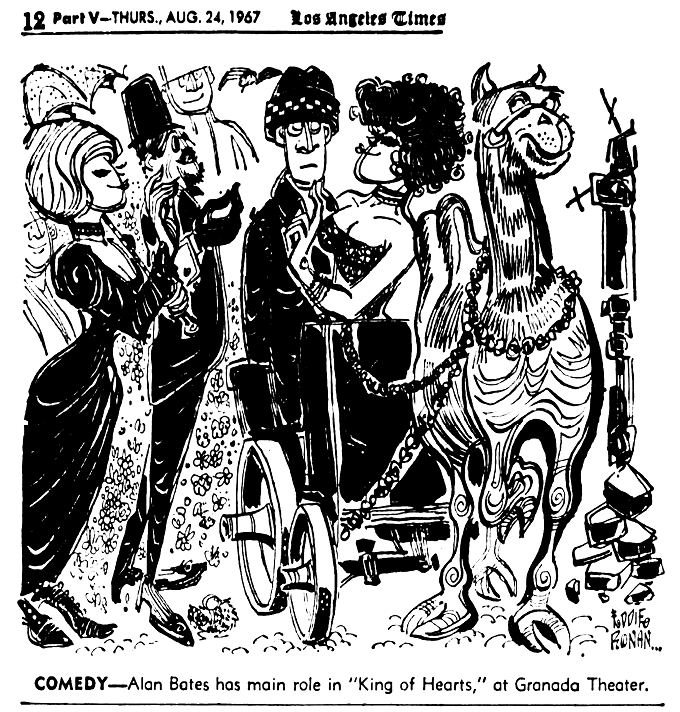
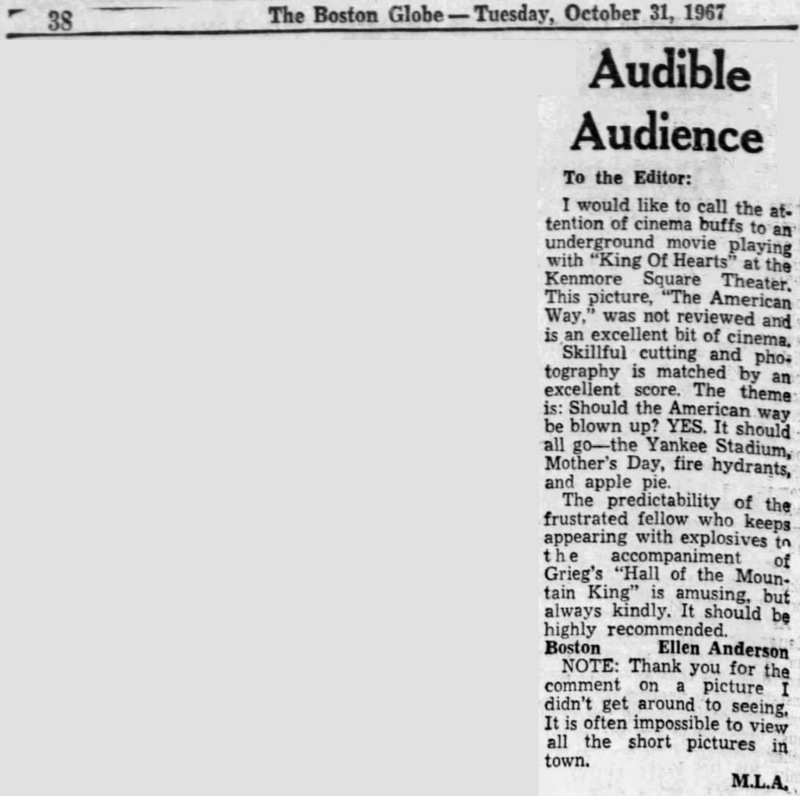
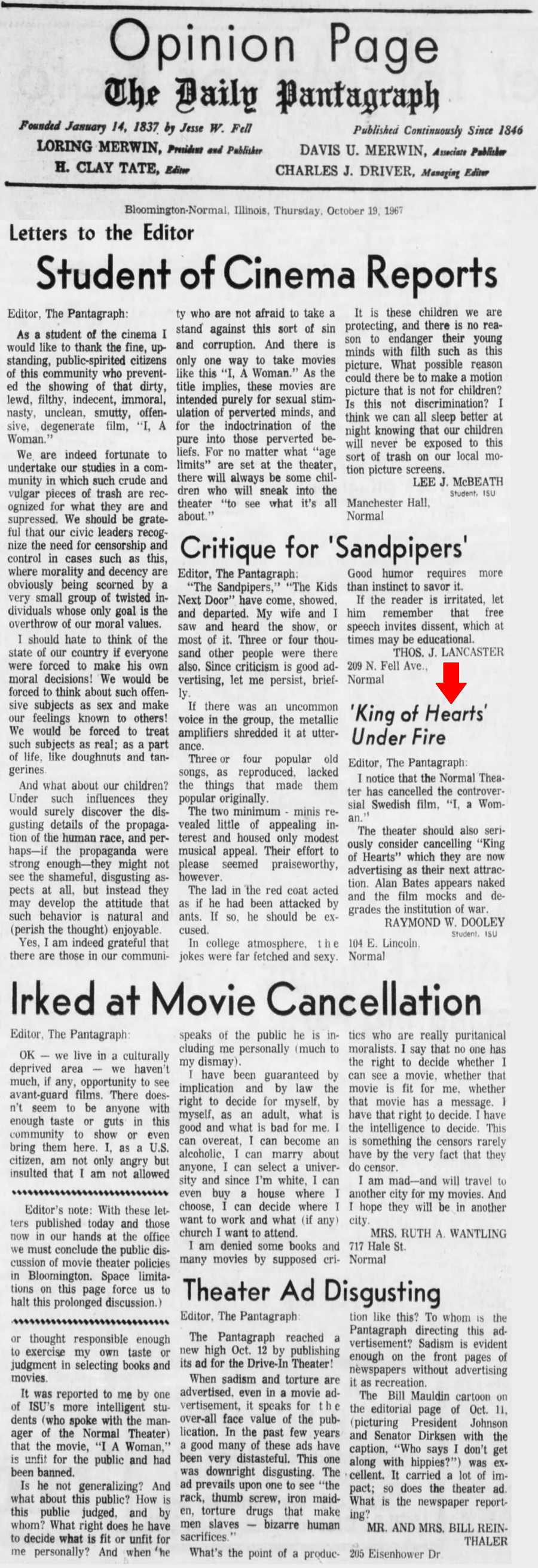
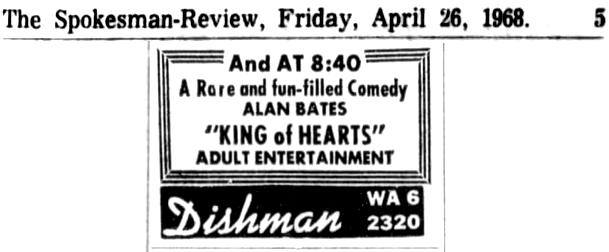
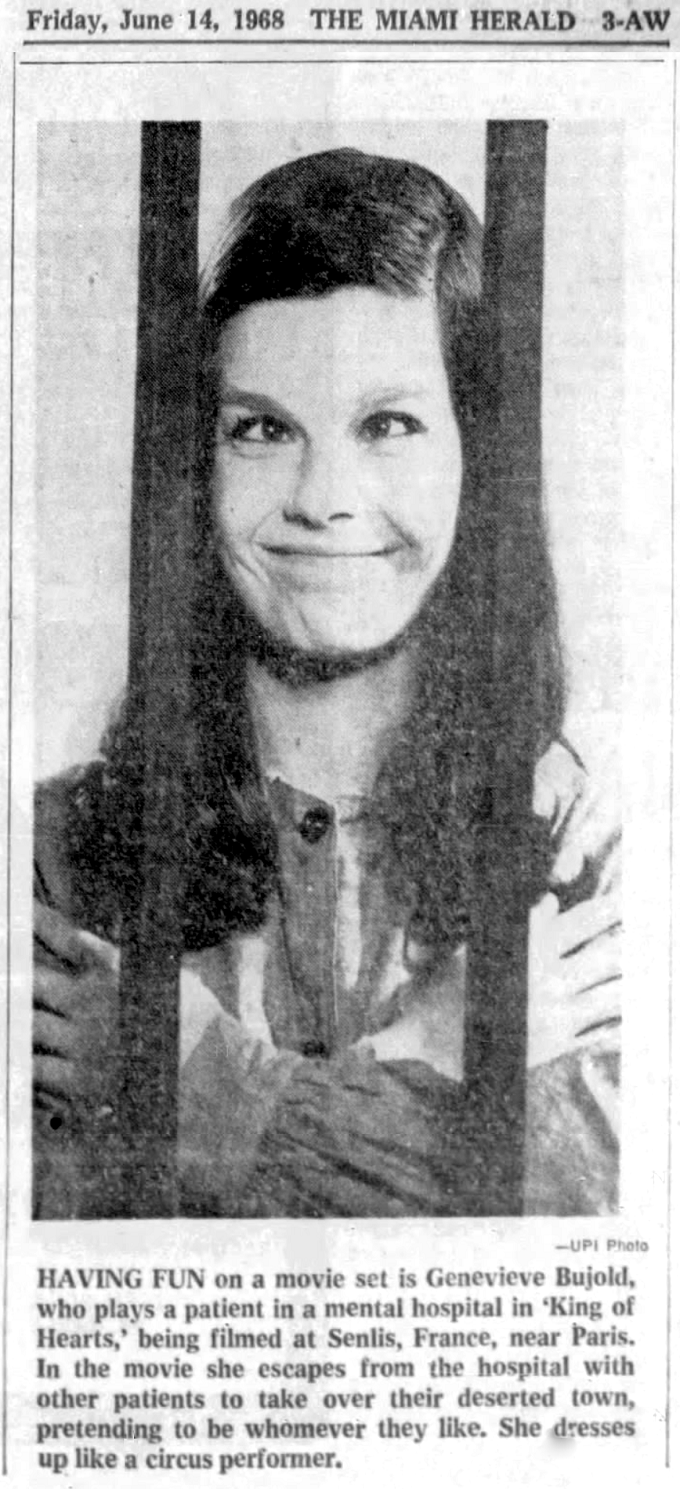

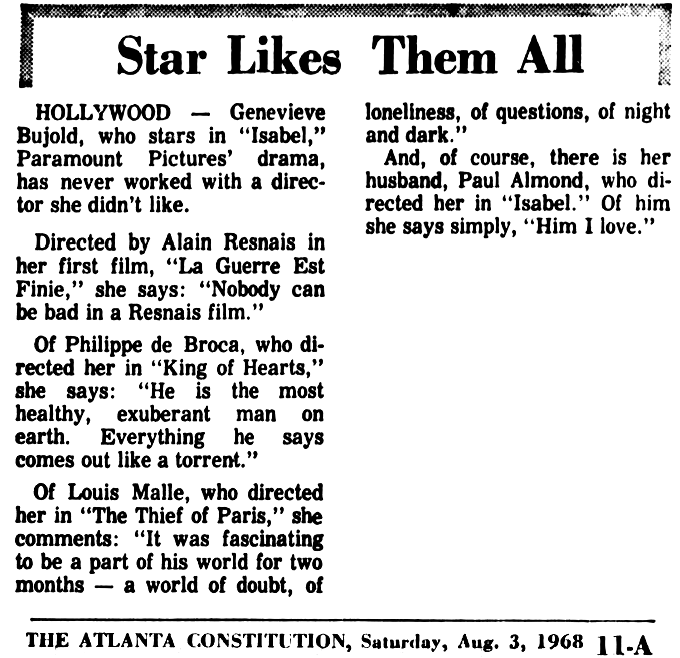
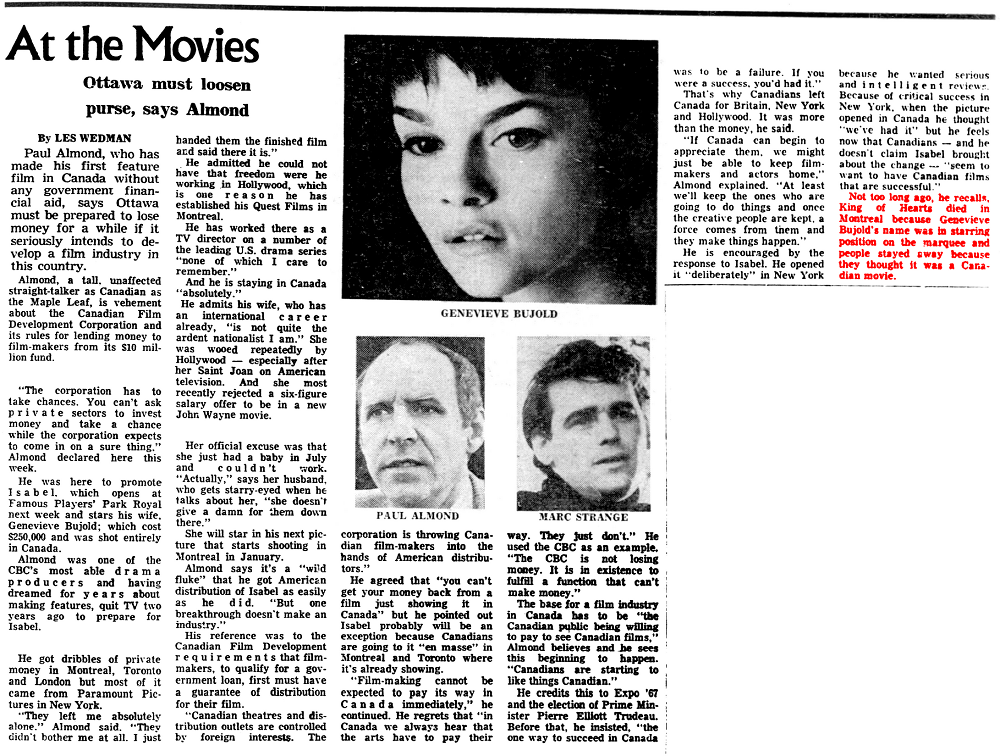
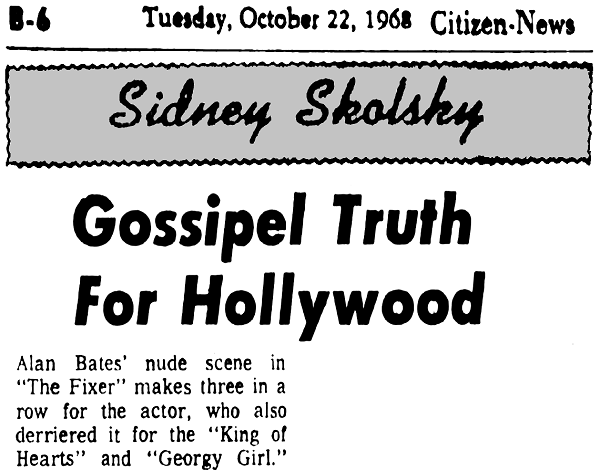
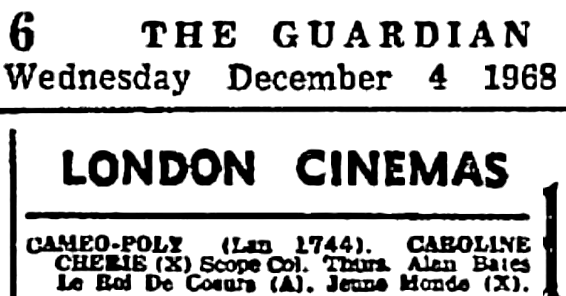
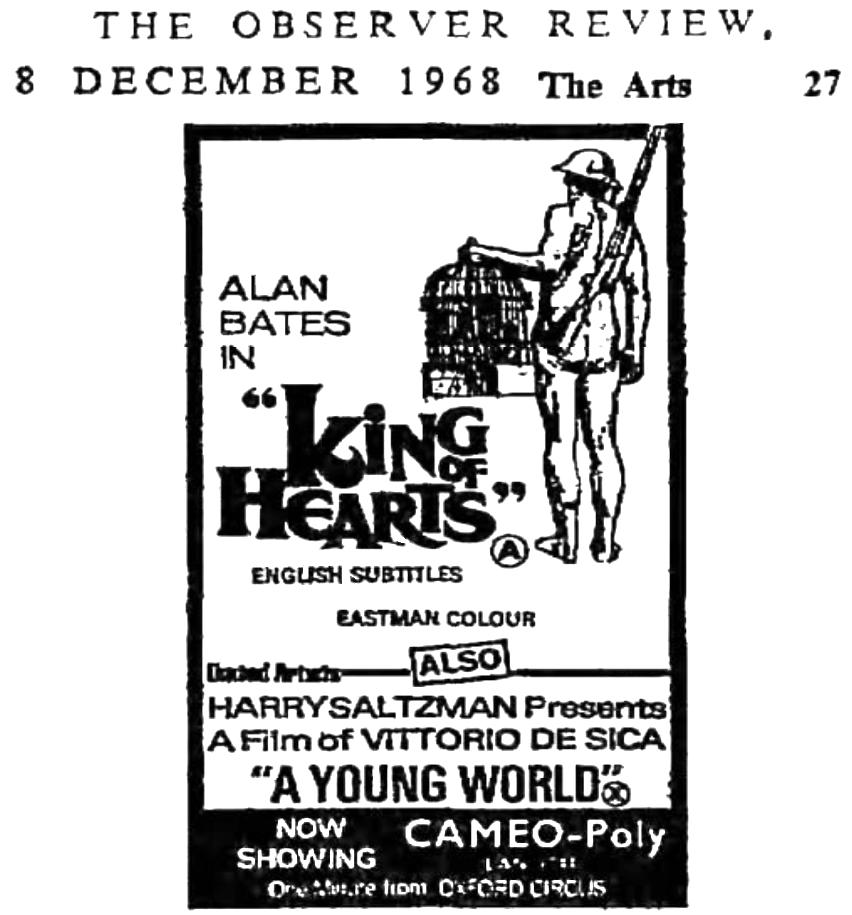
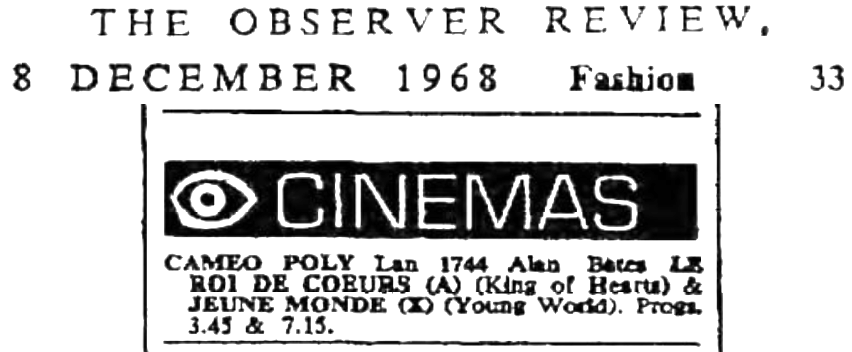
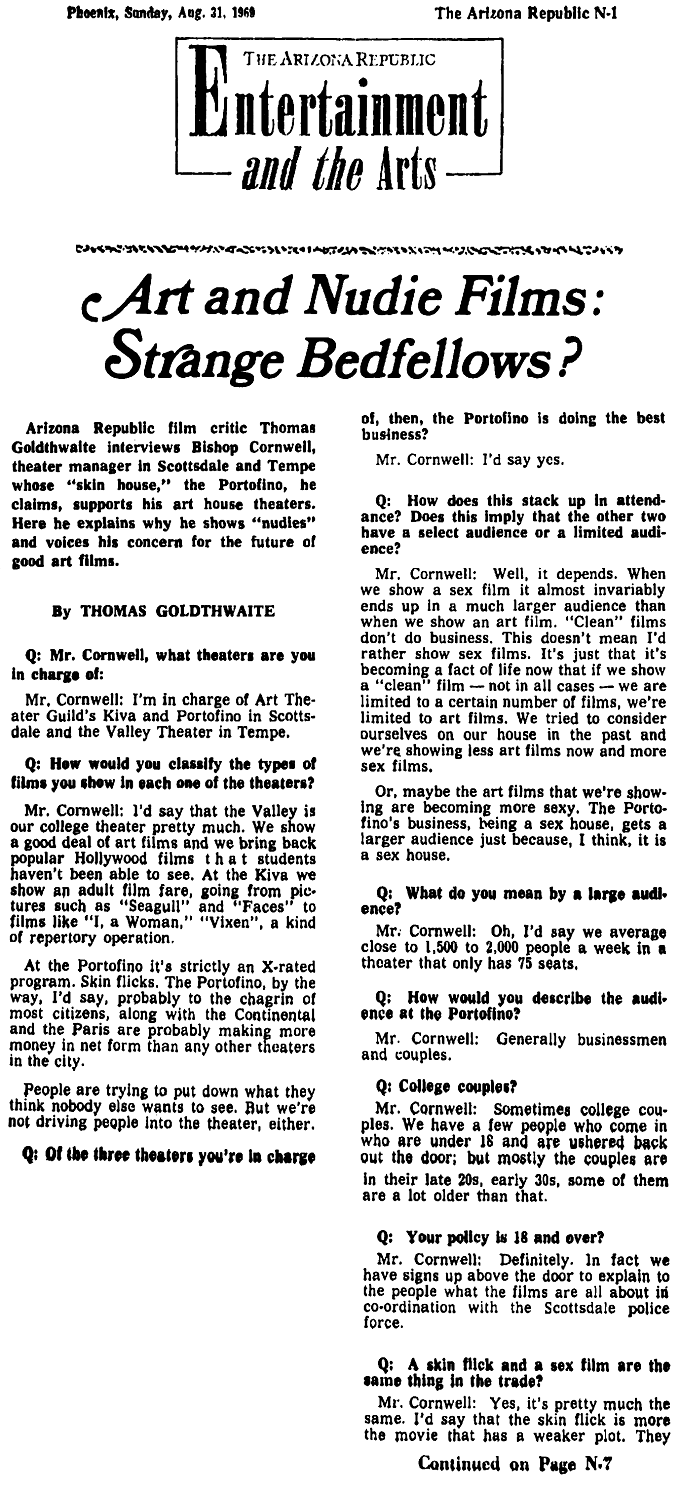
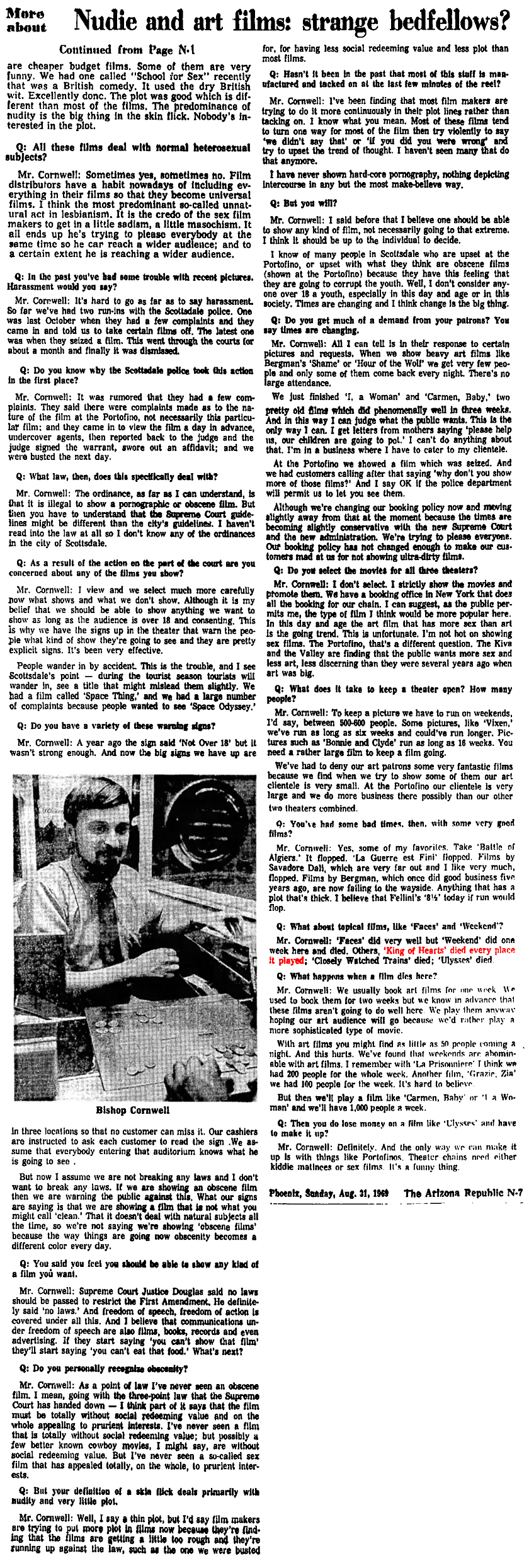
 Original US 1-sheet, 1967, Lopert Pictures Corporation.
Original US 1-sheet, 1967, Lopert Pictures Corporation. Australian daybill from the dubbed release of Sunday, 24 August 1969,
Australian daybill from the dubbed release of Sunday, 24 August 1969, 

